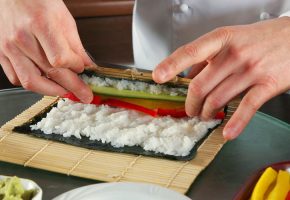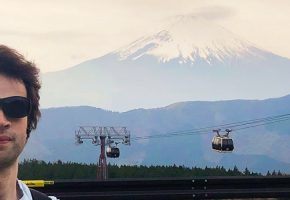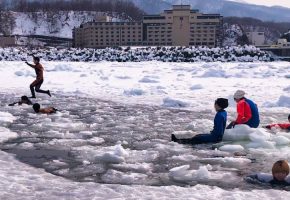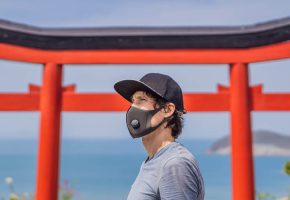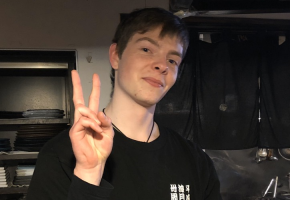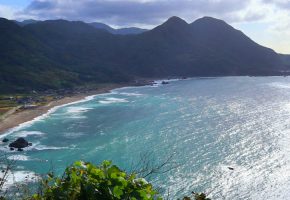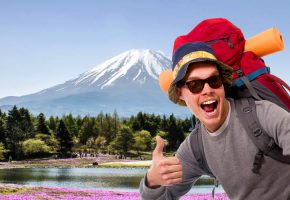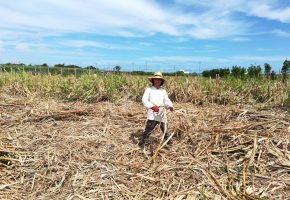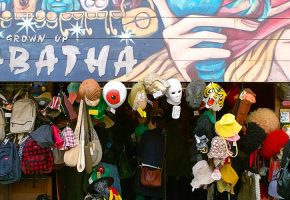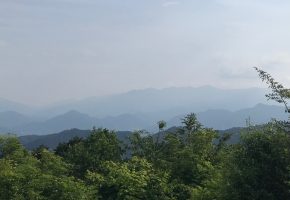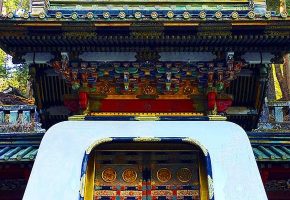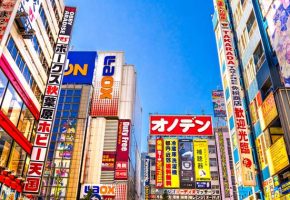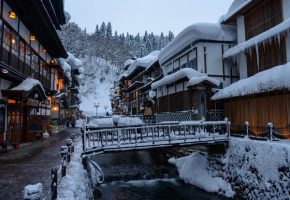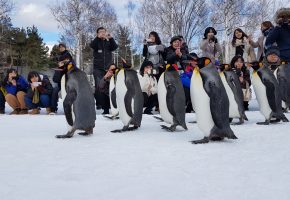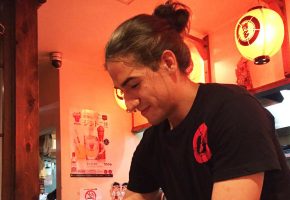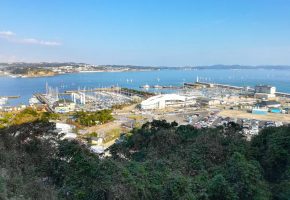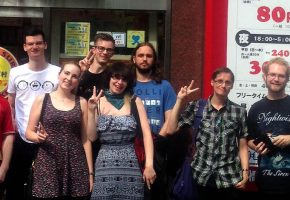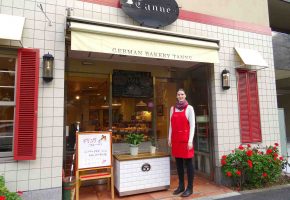Archives
- all
- Pop Culture
- Preparation
- Time in Japan
- Tokyo Things To Do
- Travelling
- Working
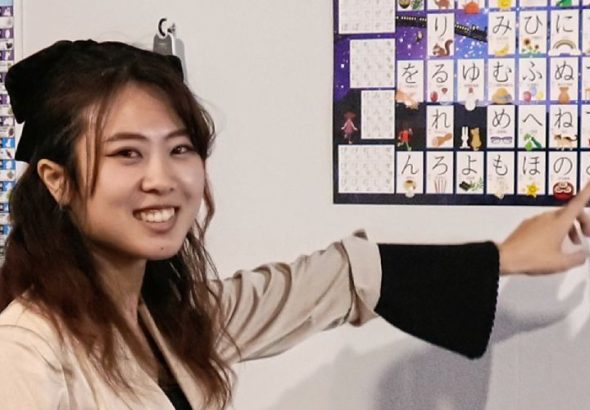
World Unite! has launched an intensive Japanese conversation language course tailored specifically to the needs of those arriving in Japan on a Working Holiday visa. The aim is to enhance listening comprehension, speaking skills, and basic reading skills as rapidly as possible. Beginners can commence the course once per month and are welcome to participate for any duration ranging from 1 to 8 weeks, with rates that are very affordable. We spoke with the lead language instructor, Megumi Taguchi, who also developed the educational materials, to learn more about the course. Who is the course designed for? The course is tailored to meet the needs of foreigners arriving in Japan on a Working Holiday visa. For them, possessing basic conversational Japanese skills can significantly broaden job prospects and income opportunities, enabling effective communication with Japanese customers or colleagues. They require rapid language acquisition and skills relevant to their circumstances. Additionally, individuals undertaking internships with Japanese companies or engaging in volunteer work in Japan can greatly benefit from the Japanese conversation skills acquired through this course. Given that we offer flexible enrollment options starting from just one week and do not impose costly registration fees, we also warmly welcome tourists or travelers interested in learning the Japanese language. What aspects of the course do students most appreciate? My students often expressed that the textbook structure was the most effective aspect of the course. They found it clear and understandable, allowing them to grasp the rules and independently construct sentences and conjugate forms. Moreover, they appreciated the additional homework and practice sheets customized to their individual needs, as it enabled them to focus on areas for improvement in their Japanese skills. Could you please provide a brief overview of the course content? The course offers fast-paced and intensive learning experiences beneficial for students' daily lives. Students can book lessons from 1 to 8-week durations. If you are not a total beginner, but you already know a little, you can join a course after it has started. A placement test is available to ensure the appropriate level. During the initial 2 weeks, students will acquire an understanding of basic Japanese sentence structure and word order. Each day, we will also be learning hiragana, with one column covered per day. During weeks 3 and 4, you will acquire proficiency in various Japanese linguistic elements, including past tense, formal forms, continuous forms, te-forms, imperative forms, conditional statements (if, when, even though), causation, subjective and objective expressions, comparison, and interrogative sentence structures. Each day, we will also be learning katakana letters, with one column covered per day. During weeks 5-8, you will have thorough review and practice sessions covering all previously learned forms, as well as opportunities to enhance your speaking and listening abilities. Furthermore, you will acquire proficiency in using a more formal speaking style enriched with advanced vocabulary, which is essential for working in Japan. Can you share a bit about your background and experience? With 2 years of experience teaching Japanese across 11 countries, I have taught in US colleges, Japan, and online platforms. I am enthusiastic about implementing innovative teaching methods, such as creating my own textbook. My textbook is developed based on various feedback from my students. For example, I identify the most challenging aspects of learning Japanese from my students and strive to provide clear explanations of Japanese rules and systems in English. This approach helps students grasp concepts more rapidly and comprehensively. Additionally, clarifying the differences between English and Japanese structures and expressions enhances students' understanding of the Japanese language. What other options do students of this course have to improve their Japanese? At no extra charge, we offer language exchange events twice a month and a social meetup once a month, fostering friendships and conversation partnerships. Our cultural events, which come at a little extra cost, provide a deeper understanding of Japanese history and culture, offering diverse perspectives to enhance your learning experiences. Students seeking higher proficiency levels after completing the 8-week course can access other schools that we cooperate with and continue their learning journey. Thank you, Megumi for your insights! 😃 You can book the lessons via World Unite! Japan KK: BOOK LESSONS HERE!
Cooking course, language lessons and culinary internship in Japan If you are a fan of Japanese cuisine and want to get to know it first hand and in depth, this program is just right for you! You will spend the first month in Tokyo, taking part in a cooking course and in Japanese language lessons. You can decide whether you prefer to stay with a Japanese host family or, more affordably and independently, in a sharehouse (self-catering). The basic Japanese language skills that you acquire through the participation in the language course is required for the second part of your stay in Japan - the restaurant internship on rural Sado Island. You will then spend the second and third month on Sado Island on the west coast of central Japan in Niigata Prefecture. Sado is a picturesque island with a strong local culture and is also particularly known for local seafood specialties (shrimp, crabs, squid, fish, oysters, abaolone and turban shellfish) as well as seaweed such as wakame, mozuku and iwanori, shiitake mushrooms, traditionally grown rice and persimmons. Sado has several producers of sake, igoneri (seaweed jelly), meat products and other local specialties. Many domestic Japanese tourists travel to Sado for culinary experiences. You will do an internship in a typical Japanese restaurant that specializes in yakitori, ramen, sushi, gyoza or other Japanese or local specialities. There are also two culinary day visits included in the program. You will live in an apartment or in a temple's guesthouse, depending on the location of your internship restaurant. START DATES 2024: January 5, February, 2 March 1, March 29, May 3, May 31, June 28, August 2, August 30, October 4, November 1 and November 29 BOOK NOW! ITINERARY Day 1 - 3 Arrival in Japan, accompanied pick-up from Narita or Haneda airport by public transport and escort to your accommodation (you can choose between a Japanese host family including breakfast and dinner, accommodation in a single room) or a sharehouse (accommodation in a 4-8-share dorm room together with other foreign interns). Saturday and Sunday at leisure. Day 4 - 28 Monday to Friday you will join our intensive language lessons from 9:10 to 12:40 (a total of 20 lessons x 50 minutes/week). You can join the course as a beginner, but also at other levels if you already know some Japanese. You need to do a proficiency test if you want to start the course at a higher level than beginner (available up to upper intermediate). The cooking classes are held 8 times. The English-speaking cooking teacher is a professional chef. Class 1: Japanese food basics The 5 taste concepts (sweetness, saltiness, acidity, bitterness, umami). The 5 colours: red, green, yellow, white, black The 5 methods: bake, simmer, fry, steam, raw Chopstick manners and basics of serving meals Cooking: Grilled fish, steamed egg custard, Japanese mustard spinach with sesame sauce, pork miso soup, white rice Class 2: Easy Japanese dining table setup with rice pot cooking Oyakodon, mizuna and jako salad, instant radish pickles, tofu and shiitake mushroom miso soup. Class 3: Colorful bento with five colors Fried chicken, boiled hijiki, tamagoyaki, boiled spinach, kinpira burdock root, white rice bento Class 4: The concept of "Sashisuseso" Nabe-daki rice, mackerel simmered in miso, meat and potatoes, vinegared seaweed, ginger and cucumber, miso soup Class 5: The role of seasonings in Japanese food and how to make dashi Mixed rice or sekihan, boiled in Chikuzen, horse mackerel pickled in Nanban, clear soup Class 6: Japanese sweets 1 Mizuyokan Class 7: Japanese Sweets 2 Kingyoku and Nerikiri Class 8: Other Japanese dishes Cutlet curry rice and Japanese potato salad or Dumplings and Hiyashi Chuka (Cold Ramen) Accommodation is with your host family (including breakfast and dinner during weekdays and including 3 meals on Saturday and Sunday) or in a sharehouse (shared, self-catering accommodation). The host families mostly live in Saitama, Chiba, Yokohama or in the west of Tokyo. The sharehouse is located in Koto-Ku near Kiba Station. Not included in the price: Commuter ticket for local public transport in Tokyo (between your accommodation and the language school and cooking school; approx. 6500-10,000 JPY for the entire duration). Day 29 & 30 Travel from Tokyo to Sado Island by Shinkansen bullet train and ferry (total travel time approx. 5 hours). You pay for the train and ferry costs yourself, around 14,000 JPY. We will pick you up from the Sado Ferry Terminal (Ryotsu) and drive you to your accommodation on Sado. Accommodation is chosen depending on the location of the restaurant where you would do your internship. In case of the central Sado and Ryotsu area, you will stay at a self-catering rental apartment, single room. The apartment are two-room apartments where you will share kitchen, toilet and bathroom with another participant of the program. In case of a restaurant in the Ogi area of Sado, you will stay at the guesthouse of Koninji Temple at a single Western bedroom, sharing sanitary installations and kitchen with other participants. In case your accommodation and restaurant is in the central Sado or Ryotsu area, you can reach your restaurant by walk, bus (communiting costs at your own expense) or bicycle (provided to you free of charge if needed). In case of the Ogi area, you reach your internship restaurant by bicycle (provided free of charge). Days 31 - 89 You will do your restaurant internship. You will be in the restaurant 4-5 days a week for 4-8 hours each as an assistant to the local chefs. Japanese restaurants typically only prepare one type of food, so the restaurant where you will do your internship will most likely specialize in one certain type of food only such as Yakitori, Ramen, Sushi or Gyozo. Once a month there is a full day trip (included in the price). The date will be decided depending on the availability of all internship participants. First month: Natural herbs collection in the forest and visit to/workshop in a herbal tea factory Second month: Traditional rice cultivation / harvest (depending on season) Accommodation at your apartment room or at Koninji Temple. Day 90 Transfer to the Ryotsu Ferry Port in Sado and return travel to Tokyo (at your own expense) for your outbound flight (visa validity for most nationalities is 90 days, so please make sure to book your return flight accordingly) You can do this program on a Temporary Visitor Status or Tourist Visa (or other long-term visas for Japan that you might arrange on your own). If you are unsure about possible visa options for your nationality, please consult with WORLD UNITE! before booking the program. RATES For 1 person: 2980 USD For 2 persons: 2880 USD for each Host family accommodation (for 30 days): +769 USD Do you want to join this Culinary Internship? Contact us now!
In Tokyo, you can join a 1-3 months course combining MANGA DRAWING and JAPANESE LANGUAGE LESSONS! " order_by="sortorder" order_direction="ASC" returns="included" maximum_entity_count="500"]The course is an exclusive cooperation between Mangajuku, the number one Manga School of Japan, located at Jimbocho in central Tokyo, which has brought fourth many professional manga artists, and a well-established Japanese language school. For this course, a professional manga artist joins force with a bilingual (Japanese + English) coordinator, so you can join this course without having any Japanese language skills. While studying Japanese language in the mornings (20 hours per week), you learn how to draw manga characters, to develop storylines, draw backgrounds, from analog to digital. The manga drawing classes are in the afternoons (the 4 weeks course includes a total of 5 manga lessons; 8 weeks 10 manga lessons; 12 weeks 16 manga lessons x 120 minutes). The course is available for everyone from the age of 15, both for complete beginners in drawing, as for those who are experts at drawing but would like to broaden their expertise in Japan. Also, the language lessons exist for different levels, from beginner to upper intermediate. The rates for the course (Japanese + Manga) are: 4 weeks: 154,000 Yen 8 weeks: 268,000 Yen 12 weeks: 392,000 Yen The next start dates are: October 2, 2023 April 1, July 1 and September 30, 2024 NOW BOOK THIS COURSE! Details about the course: 1. Orientation to the course and outlook of Japanese Manga Self-introduction of the participants and orientation to the course. Exercises. Drawing with a dip pen, filling in procedure, whitening out with liquid and screentones. 2. Character faces How to draw the face. Deformation theory and expressive techniques to show human feeling such as joy, anger, sorrow and pleasure. 3. Drawing the character as a whole Positioning technique of the whole character. Head and body and their proportions. Deformation and attractive poses. 4. Character design 1 Methodology of characterization through fashion, body shape and hair style. 5. Character design 2 Drawing the character in different thema of Japanese Manga. The 4 weeks course finishes here. If you continue, you will learn the following contents: 6. Character motion Practice in drawing running characters. Practice in creating the side composition, or composing from a previous composition. 7. Professional Character Design Actual hands-on experience with a professional manga artist. Lecture about the typical work of a professional manga artist. 8. How to draw the background The basic methodology of background art (clouds and skies trees and leaves, seas and waves. Shaving technique using screentone. 9. Scene allotment Basic description of the panel layout. Trial production of 1 page scene allotment based on an existing story. 10. Digital production (monochrome) Drawing Manga using "CLIP STUDIO PAINT", a piece of computer software. The 8 weeks course finishes here. If you continue, you will learn the following contents: 11. Graduation project 1- monochrome (Draft) Making a cover page of the manga in your debut as a professional manga artist. Drafting with a pencil. 12. Graduation project 2 (Pen lining) Making a cover page of the manga in your debut as a professional manga artist. Pen lining, putting in title (in case of handwritten) 13. Graduation project 3(Digital color)1 Coloring of the project work by a computer. Coloring of the cover page. 14. Graduation project 3(Digital color)2 Completion of the digitally colored graduation project. 15. Field trip Observation trip regarding manga history and viewing of videos for drawing manga. 16. Final comment and graduation ceremony Review and comment on each graduation project. Presentation of the completion certificate for the course. Do you want to join this Manga Course? Contact us now!
I went on a trip to Hakone and bought the Free Pass which gave me unlimited access to a range of different modes of transport as well as a round trip back to Shinjuku. The first stop was the Open Air Museum which features all kinds of quirky art structures but the highlight was definitely the symphonic structure that is grey and plain on the inside but a wall of colour within. The Hakone ropeway is a popular form of transportation in Hakone. This mode of transport is entirely free with the Hakone free pass. However, this is more than just a means of getting from A to B (which it does a very good job in taking you to lake Ashi) as it is an experience in its own right. One moment you are sailing above the trees and the next you are over the top of the mountain ridge and looking at the face of a volcano. Also, if you go on a clear day like I did then Mount Fuji is visible enough to snatch a photo of. Immediately after getting off the ropeway you are deposited at the shores of lake Ashi where a pirate ship awaits and at times like this it genuinely felt like the halogen area was one big sightseeing assault course with tourists carried along by the different and contrasting modes of transport as if they were on a conveyor belt. In truth I didn’t think the boat ride was that impressive, in fact it was the opposite of the symphonic structure in the Hakone Open Air Museum in that it was grand on the outside but ordinary within. In fact, I was more interested in speaking with some Canadians I met than I was in the boat ride and we discussed our Japan travel experiences at length. At the end of the boat ride I had the choice to go to Hakone shrine to the north or Mishima skywalk to the south and I decided to go with the latter as it was the path less travelled. I arrived at sunset and there were views of a sunset, suspension bridge, Sakura and Mount Fuji all at once. It was raining on the second day in Hakone (and a second day is necessary if you want to see the majority of what is on offer in the area) so I went for an activity that didn’t require good weather, the Hakone Glass Museum. When I arrived it didn’t feel like much of a museum at all but rather a quaint, fancy garden with many of the trees and bushes replaced by glass. While the individual exhibits weren’t jaw dropping, but like many of the other things they came together to create a mystical and peaceful atmosphere where you could sit and relax without overwhelming hordes of tourists which made a nice change from bouncing from one tourist hotspot to another. The most underrated attraction in the Hakone area by far was Tamadare falls. So underrated that it doesn’t even feature on the area map you get with the Hakone free pass (you need Hakone Yumoto station, OH51). In fact the only reason I knew about it was because the other English person who arrived at the sharehouse the same time as me went there and I saw their pictures on Instagram. I am glad I decided to be a copycat as it was one of my favourite places. The statues of dragons spitting water, the koi fish, the crimson-leaved trees and of course the waterfall with a pond complete with stepping stones made for some really good scenery. Also, because this area is relatively off the grid you also could still feel the atmosphere of the place as it wasn’t drowned out by crowds of tourists. I was in no particular rush to head back to Tokyo and I had seen everything I wanted to see so I decided to stop by Odawara castle. I arrived at about a quarter to 5 so there was little point in me paying to go inside the castle if it was going to close in 15 minutes. However, that didn’t mean the trip was wasted at all, the castle grounds and walls on the outside were more than sufficient to get a feel of the place and get some good photos in the process. Report by our participant Jacob
Hokkaido My first day's trip at Shiretoko National Park was split into three parts: snow shoes walking to see nature in the forest, drift ice walking on the frozen sea of Othosk and animal and coastal views at sunset. Moved a little south down the eastern side of Hokkaido. Originally I had intended to go to lake Mashū but the road was blocked so I went to Mount Iō instead and then the town of Kawayuonsen which had a nature trail with deer running free (which was quite a surprise as the trail I got first wasn’t on any map). I visited the Akan Crane Center for day 3. Unfortunately I narrowly missed the bus in the morning and had to wait over 4 hours in Kushiro for the next bus, by which time the cranes were almost all gone, but I could still get the odd decent pic of them. Public transport in Hokkaido is far worse than that in Tokyo and you really need to have things planned out and get up really early at times. I left the east of the island behind and headed for the heart of Hokkaido. This involved a train across the island which passed through endless fields of snow. Since there was heavy sleet and snow that day, I decided to make it a day. I went to see the zoo in Asahikawa where a range of different species from the world’s coldest climates could be found. In the evening I returned to Furano where I was based and walked along Ningle Terrace which is an arts and craft shopping area made entirely of wooden cabins in a forest illuminated by fairy lights. The 5th day got off to a rather bad start as the main purpose of my trip to the Shirogane area, near the town of Biei (within an hour of Furano) was to see the blue pond. However, at this time of the year (March) the pond is frozen over and covered with snow, so barely to be seen. I then headed to Shirogane Falls but enroute I found a gap in the snow drift that went into the trees and I found the relatively well concealed Fudou falls, which has a very uncanny resemblance to a stone staircase. Continuing along the road through the whitewashed landscape I reached Shirogane Falls and was pleasantly surprised to find the blue colour of the water was alive and well here after all. The water was so clear you could see the stones of the river bed even from up high on the suspension bridge. On my 6th day, after a 3 hour bus ride from Furano to Sapporo I felt like the trip to Hokkaido had already ended as it felt like I had returned to Tokyo with a dusting of snow as I had left behind the mountains, ice floes and blue rivers and traded them in for them towers and shopping centres. However, in time I would come to learn that this was in many ways a different place to Tokyo as while it shared many of the conveniences, it did not suffer from the overcrowding the way Tokyo does. In fact I felt like I had a lot of room to roam free, and so I did. I came across many things including the tower, both day and night, an underground shopping centre with exotic birds, the Susukino entertainment district and a giant ferris wheel placed in the center of the main outdoor shopping arcade area. I didn’t have much energy left on the 7th and final day, in fact I didn’t leave the hotel room until exactly the last possible minute I could to check out. I spent the day going around looking at things within a striking distance of the city centre before getting the flight back to Tokyo from Sapporo late in the afternoon. I came across a fish market, a lacklustre clock tower, a pachinko slot arcade and the main outdoor shopping street/arcade. Japanese Alps For the first day on the trip to the Japanese alps I went to Nagano prefecture to see the snow monkeys. There was very little snow left in the middle of March but an abundance of monkeys could still be found. This area is famous for monkeys bathing in the onsen but it was too hot for that (although one did fall in) and they all seemed to gather around the onsen like holidaymakers in Spain gathering around the swimming pool on a sunny day. The thing about the monkey park is although it certainly feels very touristy you still get to have a ‘real’ experience of seeing the monkeys as they act as if nobody's watching, often passing by humans without stopping to look to go off and see other monkeys. In the morning of the 2nd day I went on an hour-long ride to the lowest level of the three tiered shrine complex of Togakushi. Togakushi is essentially a group of shrines that are scattered up the mountain at 3 points of different heights. The ascent to the top involves an increase in altitude of over 100 flights of stairs. I may have picked a bad time of year (March) to go as although it was spring at the bottom it was still very much winter at the top and the shrines were buried in snow to the point I nearly missed them entirely. There was also a tree corridor where half of it was missing as only the conifer trees had kept their leaves. The snow and cold climate caused further problems as the route to the mirror pond was blocked off so all things considered you should wait until at least at the end of spring to come. I returned to Nagano in the afternoon and spent sundown walking around Zenkō-ji. Practically having the temple to myself was a peaceful way to spend sundown on a spring evening. I also liked the atmosphere uphill road leading to the temple, especially at night where it is lit up by street lamps and the mountains cast a strong silhouette in the navy evening sky. At the halfway point of my trip in the Japanese alps I visited Matsumoto Castle, one of the most famous in Japan. In my opinion, the outside of the castle grounds actually looks better but the inside is still worth visiting at only 700JPY. On the inside you can go inside the castle (which feels more like a matchup between a multi-storey shrine and a museum than a typical castle). On the fourth day I went for a ride on the Shinhotaka Ropeway (which can be accessed by bus from both Matsumoto and Takayama). The ropeway barely gets a mention from the guidebooks and online travel blogs, making it the most criminally underrated attraction I have seen in Japan so far. The views at the top of the mountain range were amazing. However, when you come in the winter months there is another thing to see, a mini snow corridor as high as you are running through the trees. The only bad things about the trip are that it takes hours to reach by bus and it is one of the more expensive things to do. Nevertheless, it is still the most impressive sight I saw in the Japanese Alps region. The final part of my trip to the Japanese Alps region was visiting the UNESCO world heritage site of Shirakawa village. I have never been anywhere like it. Even to reach it you have to spend half an hour in darkness going through a mountain tunnel and when you emerge on the other side you arrive at a place composed entirely of thatched roof wooden buildings. When I was walking around the place in the drizzle I couldn’t help but think that it was very much like where I am from in the UK. Both are surrounded by green fields, both are in close proximity to the mountains and the biggest similarity of course being the incessant drizzle that was pouring that day. Report by our participant Jacob
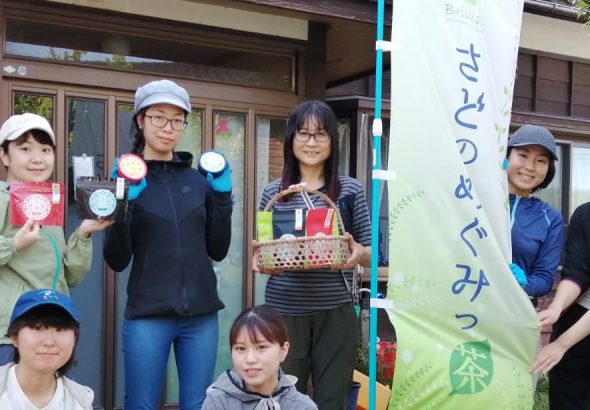
Serena T. (26) from Australia told us about her experience working for a tea plantation on the Japanese Island Sado, located 30km off the coast of Niigata, the largest city on the west coast of Honshu (Japan mainland). From spring 2020 she was staying on the rather rural island, experiencing Japanese daily life and traditional work at the same time. Serena, how did you find that job? Originally I wasn’t the one that signed up for the job. There was a girl at the share house in Tokyo that I lived in and we hung out a lot. She told me that she was going to have an interview with the employer of that tea plantation, arranged by World Unite!. However when the pandemic started, that girl returned to her country. I was very interested in Sado Island too, so I told them if they were looking for someone to fill in that position, I’d be happy to take the role. The interview was then arranged for me instead. Did you speak Japanese prior to the interview? Not really, I knew just a bit. But I had a translator from World Unite! attending the video interview, so it was not a problem whatsoever. Actually, I was originally planning on taking 4 weeks of language lessons when I arrived in Tokyo in February 2020. Though due to the pandemic, things were obviously kind of uncertain and the school needed to postpone the classes for a few weeks, and then decided to do them online for the time being. On Sado Island I was asked to do 2 weeks of self isolation; I used that time to attend the Japanese lessons online. Was that enough to communicate with your employer and the other employees during your work now? When they brought me in for the first time, I actually learned some Japanese from the classes, so I could listen in. Also the employee knows I am foreign, so she speaks very slowly for me. so she was speaking very slowly. Otherwise I relied on body language to understand for example what she is telling me to do during work. I think in my opinion you would need to know at least a little bit of Japanese like the basic part of it, in order to work with them, because they don’t speak any English. When I needed to ask any important questions that I didn't want to get wrong, I communicated with the employer through World Unite! or through a new staff member who recently joined the team who speaks some English. How does a typical work day look like for you? So in the morning, from around 9:00am to 11:30am we would go out to certain parts of the island to pick leaves or grass, depending on what the employer wants us to produce. After that we would return back to the workplace and have lunch for an hour. After that we would wash what we picked, cut it down to smaller pieces and then we would dry them in a machine. And then we would break down the dried leaves from the previous days and put them into bags. That’s pretty much our whole day’s process on a sunny day. On a rainy day we would (instead of picking) be busy with packaging. Putting the leaves into tea bags. May I ask how much you work and how much you are earning? At the moment I'm working 4 days a week, starting at 9:00am for around 4 to 8 hours, depending on how much work we have. The hourly salary is around 830 JPY, which is the minimum wage in Niigata prefecture. In the beginning I was only working half days, because I was still attending language classes during the morning. When working full days, the salary is enough to make a living, especially because my rent is quite affordable. I’d still recommend people to bring some savings when doing a Working Holiday in Japan. Things that you haven’t considered can always happen, like the rainy season when there is less work to do on farms like mine. How is it to live on Sado Island? With Sado Island, I think I have settled down and I’m quite happy here. Because all I’ve known Japan for was pretty much just Tokyo and Kyoto. Once I got here it was a very different sort of feeling. I’ve grown up in the city all my life and to come here where you see mountains in the distance instead of high tower buildings, is a very nice change of pace. From a fast paced environment to a very relaxed environment. Plus, I get to just focus on studying Japanese here. What are you doing in your free time? My previous roommate had introduced me to other foreigners on the island that I go out with a lot. They have a car and can take me around the island [laughs]. Staying at home, I’m doing some yoga, trying to exercise on my own and study. During the evenings I take private online Japanese lessons by a teacher that also lives on the island. What did you do back in Australia and what are your plans after leaving Japan? I worked at banks and an insurance company. And what I plan to do afterwards, I have not decided yet [laughs]. But I will stay in Japan until next February, as I’m planning to stay for the whole Working Holiday year. What’s your advice for future Working Holidayers? When it comes to the mindset, as long as you show an interest in Japanese culture and language and are willing to learn, you are good. The Japanese people I've met love to learn, they really love asking questions, so as long as you are open to also bringing some of your culture to them and are actually open to sharing, they would be open to share with you and learn something from it. Also, if anyone is looking to escape the city life, Sado Island would be pretty good! This interview was conducted in July 2020.
There can’t be anyone left living in or visiting Tokyo who hasn’t seen them at least once: groups of go-karts dashing through the streets, dressed in colorful costumes of lovable cartoon or video game characters. But did you know that you can not only join those cheerful groups as a tourist, but actually work as their tour guide, leading the squad through the exciting city? Adam E. (28) from Australia landed one of the popular jobs as a street-go-kart guide and told us everything about it. Adam, how did you originally find that job? So basically I went on a holiday to Japan before. And doing the street kart tour myself as a tourist. I looked at the guy in the front and thought, “He’s getting paid for this! If I can I want to come to Japan and try this.” But when I first got to Japan for my Working Holiday then, the company just hired someone, but I sent them an email anyway, introducing myself. Said I love driving, meeting new people, Tokyo and everything about it. Since then I checked the job market every day for the job to become available and around 2 months later it actually did. I applied officially through a job advertisement page that also told you how many people had applied for the position so far. It was exactly one person - me! The company remembered my email I sent a few months before and said “Hey, you seem pretty passionate, come in for an interview. That’s how I got the job. I knew I wanted it and I didn’t let anything stop me. I know two month waiting is generally not too bad, but it was tough to be patient for it, because of some payments I had to make back in Australia, trouble back home. But I knew that was what I wanted to do, so I even declined another offer for a second interview for a job as an English teacher that came up at the same time as the street kart job. That was quite risky, but the timing for my dream job was just perfect in the end, it came right when I needed it. Excuse this question, but what exactly is a street-go-kart guide even doing? It’s basically being a city tour guide! Just on wheels. I would go by go-kart with a group of up to 6 people (everyone has their own kart) and drive all around Tokyo, starting in Shinagawa, through Roppongi, passing by the Tokyo Tower, going through for example Omotesando and Shibuya, or over the Rainbow bridge to Odaiba, depending on the route the group chose to take. I would take pictures of the group, explain where exactly we were. And just make sure that the customers are having fun, which was the main focus of the job. Afterwards, when I came back to the office, there would be the go kart maintenance, admin stuff, greeting new customers, choosing costumes with them. Guiding customers on go-karts through the streets of Tokyo sounds challenging. Was there proper training? Yes, there was a training period. You start off in the back of the group as a customer, just watching what the other tour guide does. Depending on how quickly you learned the courses, you get to go into the front after a few times, with a small group of customers first and you have the experienced tour guide in the back following you around, giving you advice through an earpiece, for example if you lose your way. For me in the end that whole process took around a month, until the tour guide who trained me was basically just a customer observing. But I was lucky, because I had driven in Tokyo before and I remembered the different spots and in the end I knew some of the stress of Tokyo already. Different nooks and things like that. What were your general working hours? So I went a bit crazy with it [laughs]. I loved the job that much that I just asked my boss to give me as many shifts as possible. I ended up working 6 days a week, up to 12 hours shifts. But of course no one has to do that. It was just that I enjoyed it so much and on my days off I was sad. And it was probably the wrong thing doing it, but I wanted to. Generally you could do it anywhere between a full time or weekend job, or you could do it every day only in the afternoon, or however you liked it. It was kind of up to you, because it was that kind of job where you could pick shifts somewhere between morning and night. That allowed you a big flexibility. Very understandable, if you liked your work more than your free time, why shouldn’t you do it? Considering you earned money doing what you loved! Would you let us know about your salary? Sure. So I was really lucky with this job. I started off with a training that was around 900 JPY per hour. Then, once I was trained off after around a month, I was getting 1,100 JPY per hour. But the best part of it, because I was serving overseas customers, was that there were tips. So if you did a good tour, you got rewarded for it. For a few months I didn’t use my wage at all, I was just living off my tips. That was during the rugby world cup in Japan when lots of foreign travelers were around. Maybe because I loved it so much, my energy was up every tour, and that got rewarded. Do you understand Japanese? If yes, how did your Japanese skills improve while dashing around Tokyo? The best thing of all was that it was all in English, I didn’t have to know any Japanese for the job at. It was a bonus that I could speak it a little bit to communicate with some of the Japanese staff members, but not a necessity. Basically 95% of customers were foreigners from all around the world, so English was the main thing you used. That was also the most fun part of the job - meeting new people from different countries everyday. What were the general requirements for working there? As a requirement I of course needed to have a driving permit. As Australian I can drive in Japan with an international license. Other nationalities, I think for example Germans, need to get their national license translated here in Japan and then apply for a Japanese license with the translation. During the job interview the company just wanted to see how you were as a person, not my Japanese skills. After all, I needed to be a tour guide talking to people and making them feel comfortable. If you were too closed off as a person, the company may have thought “Oh, we don’t know if he is able to have fun with the customers.” Being an open character was important. If you had a little bit of background in customer service that was a benefit... Also a plus was if you knew at least some things about Japan, which I assume almost everyone who is doing a Working Holiday here does. It wasn’t too grueling to fulfill the few requirements. It was just that I really needed a license. Could you tell me something about your colleagues? It was a mix of Japanese and internationals. The managers were Japanese. And a few Japanese students were also working there as tour guides, learning English along the way. But the rest of the team were internationals, like people from Brazil, Argentina, from the UK, America. I made friends from all around the world, that was a big plus. The bonus with the Japanese staff was that I could make a fool out of myself, trying to use my Japanese skills [laughs]. That was a lot of fun. There were a few mistakes, a few laughs, but they were always appreciative that I at least tried, and because they could test their English on me, it was kind of a language exchange. What did you do in your free time? The share house that I stayed in had a lot of Japanese in it, so I’d be hanging out with them. But it also had free bike rental , so I’d just rent a bike and pick a direction and ride and take a lot of pictures of what I’d find. That was some of my favorite days, just riding around, experiencing Japan. I was living in Kanagawa, so I’d ride into Yokohama a lot, just experiencing the city. Once I knew the roads there I’d take off in a different direction. And then a few times I’d just go out into Tokyo, get some nice food, do some shopping, playing in some of the arcades. Sometimes I left the Tokyo/Yokohama area, too. I’m into the band Babymetal and went to three different concerts of them, one of them was in Nagoya. Visited a language exchange partner in Osaka. Also I hired a car a few times, visiting another friend close to Fuji. So I didn’t go all over the country, but there were a few major cities I went to, but because I’ve done a few holidays prior to my Working Holiday I was just sort of living in Japan rather than being the tourist . Could you give possible future Working Holidayers some tips? I guess it can feel daunting, but it’ll be the best thing you’ll ever do. I miss Japan every day. Just come over with a little bit of money in the case of anything unforeseen things happen. In my case I probably should have had a little bit more money before I came over. So just save up a little bit of money before you come over. And I’d just say do it, if you can. I didn't have a plan other than I wanted that job. And I somehow made it work. I think if I could do it, anybody could. Awesome, thanks for your time, Adam!
Latest update: November 19, 2020. This page answers some common questions about a Working Holiday in Japan since the issuance of Working Holiday visas has resumed in late October 2020. As procedures and regulations might change at any time, please always consult with the Japanese embassy or consulate in charge of you. This page is for basic information purposes only. All information has been collected to the best of our knowledge, but we do not guarantee the accuracy of this information. The information is not legally binding in any way. Is it possible to get a Working Holiday visa now? Yes, since end of October 2020, after a suspension of 7.5 months, Working Holiday Visas for Japan are issued again to individuals of all nationalities who can get a Working Holiday Visa. You need however a written pledge from a Japanese company ("Residence Track"). What is the written pledge ("Residence Track")? The written pledge is a document written in Japanese (see it here), which must be filled out and signed/stamped by a Japanese company, pledging that you as the traveller ona Working Holiday visa, will follow the COVID-19 related safety regulations imposed by Japanese government. The company signing the pledge takes responsibility for you during your entire stay in Japan and will face drastic consequences should you not obey to these regulations. This is a big responsibility that few Japanese are willing to take. Can I buy a written pledge somewhere? No, it is illegal for a Japanese company to just sell the written pledge. Should you find any such offer, you should be very careful if it is a legitimate one. So where do I get the written pledge ("Residence Track") from? There are three possibilities: From an employer in Japan, which is a Japanese company registered in the Commercial Register of Japan with a commercial registration number From a Japanese language school willing to issue the pledge to its language students From a Working Holiday support organization registered as a company in Japan such as World Unite! that supports you during your whole time in Japan (Source) When should I apply for a Working Holiday visa? If you book Working Holiday support with World Unite! and if you want to come to Japan as soon as possible on a Working Holiday Visa, you should allow a minimum of 3 weeks of lead time: Around one week to prepare your visa application documents and get the pledge, around 7-10 days for the embassy to process your documents and issue your visa and a little bit of buffer time to make sure you get everything sorted before the departure of your flight. In some countries you need to make an appointment with the Japanese embassy or consulate to hand in your visa application. The visa validity (the time between when the visa is issued and when you have to arrive in Japan) is currently 3 months in most cases. The one year you get on a Working Holiday visa then counts from the day you enter Japan (for some nationalities only 6 months, for Australians a maximum of 18 months). I already had a Working Holiday visa issued before the border closure in March 2020 that I have not yet used to enter Japan. Can I use it to enter Japan now? No, you need to re-apply for your visa, which is possible if you have not yet completed your 30th year of life by the time of applying for the visa. For Australians this might be different, we will add this part as soon as we have clear information. Which COVID-19 regulations do I have to follow? 1) COVID-19 tests Travellers from most countries need to provide a negative COVID-19 PCR test result (in English), with the test made within 72 hours prior to departure time of your flight to Japan. Currently only if you are flying into Japan from Australia, New Zealand, South Korea and Taiwan (and some more Asian countries for whose citizens there is no Working Holiday visa), this is not needed. This list of countries may change depending on the corona situation, so please double-check. Your flight can have stop-overs on the way to Japan, but you are not allowed to leave the airport transit area. You will then be tested again (free of charge) on arrival at the airport in Japan (only Narita, Haneda and Osaka are currently receiving international flights) and you have to wait for 1-2 hours at the health section of the airport to get the test result. You cannot have a connecting flight (from Narita/Haneda/Osaka) to another Japanese airport on arrival to Japan and quarantine there. You have to enter Japan from Narita/Haneda/Osaka and proceed directly the the quarantine location from there. 2) Quarantine measures Even if both PCR test are negative, you have to do 14 days of quarantine, which count from the day after the arrival (so it is 15 nights of quarantine). The quarantine can only be done at: a hotel that offers the possibility to do quarantine an apartment/room rented by you that is not shared (no other people are allowed to live there sharing rooms, sanitary installations, kitchen etc with you) your own family living in Japan For the entire duration of the qurantine you are not allowed to leave your room. E.g. you are not allowed to use the hotel's restaurant, breakfast room, lounge, or to go outside to do grocery shopping. So you need food to be delivered to your room. On the way from the airport to your quarantine location you are not allowed to use any public transport, shared shuttles, domestic flights or regular taxis. You must make use of a vehicle that is only transporting yourself. You can for instance use this special service. 3) Tracing apps You have to install two apps on your smartphone and use them during your entire time in Japan: A) LINE and B) Japan government's Covid-19 tracing app A) You will be asked on arrival at the airport how you can be contacted at any time while in Japan. The easiest option is to make use of the LINE app. You should install it before your travel to Japan and register it with your current (foreign) mobile phone number (which won't change in case you change to a Japanese SIM card later). You might be contacted by health ministry officials via text message asking about your health status and current location. These messages are only sent in Japanese. You must reply to these messages. World Unite! will help you with this if needed. B) Japanese government Covid-19 tracing app: Download for Android Download for Apple What will happen if I disrespect the COVID-19 regulations? The company that has issued your pledge will get serious problems with Japanese authorities and will therefore do the uttermost to avoid that you disrespect the regulations, e.g. by imposing certain rules to you (e.g. where you have to spend the quarantine), and asking you to sign a binding agreement with them, which could result in legal claims by the company if you breach the agreement. Additionally, the Japanese authorities can impose high fines to you and deportation. Conclusion: You have to take the COVID-19 regulation seriously! Is travelling within Japan currently possible? Travelling within Japan is currently possible. There is even the GO TO travel campaign by Japanese government to support domestic tourism that you can use if you are on a Working Holiday Visa, allowing you to get subsidized rates for hotels, tours, domestic flights, attractions etc. Some regional tourism associations have additional promotional campaigns, so travelling within Japan is currently cheaper than usually. What is the job situation like currently for someone on a Working Holiday visa? It depends on the sector. In some sectors it is more difficult than before the COVID pandemic, whereas others have recovered or have always remained unaffected. More difficult: Tourism related jobs (hotels, resorts...) - as regular foreign tourists can still not yet enter Japan, there are less job opportunities in the tourism sector. Tourism is expected to resume from around April 2021. Teaching English jobs - many language schools still don't have the same attendance as before the pandemics as lots of classes have changed to online. English teachers providing online lessons are often not physically located in Japan, but providing their lessons from abroad. Recovered or not affected: Restaurant jobs, factory jobs, cleaning jobs, farm work, sales jobs etc. are available.
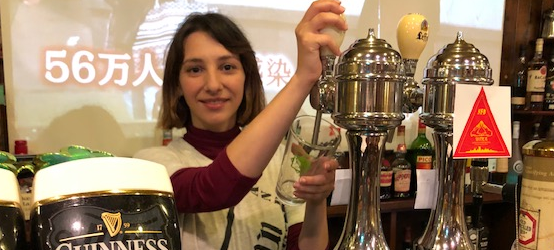
We met Jessica P. (28), a half Italian half German Working Holidayer, who is currently jobbing in an Irish Pub in one of Tokyo's busy business and college districts. Before Jessica's shift on a rainy Friday night started, we were allowed to visit the pub and interview her about her job and her exciting life besides work. Jess, thank you and thank you to your boss for letting us interview you here before opening hours! How did you land this job? My pleasure! Well, a former roommate of the share house I'm living in had been working here before. She told me that she would quit her job, because she needed to go back to her country. She knew that I was searching for a job and offered me to hand my resume to her boss, because they were of course searching for a replacement for her. In the end they didn't even want to have a look at my resume before meeting me. My roommate just set up the interview between me and the boss in the pub and I brought my resume on that very day. It was a casual and rather easy-going interview. I got the job on the spot. Did they expect special skills from you? Meaning, did the job come with certain requirements? During the interview they of course asked me, if I had experience in catering work. I had been helping out on events back home, but had no experience working in a restaurant or bar. Therefore having certain catering experience might have been a plus, but it wasn't mandatory to get the job. Skills that are really needed for the job, such as tapping beer, are taught by the supervisor. I'm still learning a lot at the moment. Nevertheless, during the interview I pointed out that I have experience in working with clients and that I can get on well with people. I think that was one of the main reasons that I scored. Also Japanese skills weren't needed, neither speaking or writing. I speak some basic Japanese, but for example the two other part timers here don't speak it at all and still can manage to work here. Although I think it goes without saying that everyone should do their homework before starting a job. For me it was to learn at least a few phrases such as "What would you like to drink?" and so on. Anyway, a lot of customers can speak English. And I also think that many of them come here especially because they like to speak English and because they want to emerge into a foreign atmosphere. How many times a week are you working here? From the beginning I was searching for a job with 2-3 shifts a week. And luckily my boss wanted exactly someone like that. My shifts start at either 5pm or 6pm and end at 11pm. By the way, the nice thing about Tokyo is that you can easily have more than one part time jobs at once. Many of my friends work one job Monday and Tuesday, another one Thursday and Friday, and maybe a third one on the weekend. Thanks to that you can experience different sides of the city, various types of jobs and of course meet all kinds of people. What are you doing besides working? The pub is the only place I'm working at right now. Which is exactly what I want, because besides that I also want to make time for a project I'm working on with a group of friends. We are trying to establish an international community where Japanese and foreigners have the opportunity to meet one another. We are organising for example girls parties or international picnics. Let's see what can come out of it. This is one of the wonderful things about life here: you arrive as a working holidayer, with no special expectations, and you end up in a great international group of friends that you can explore the city with. How does a typical shift at the pub look like? Usually when I arrive at 5pm I have to start with cleaning tasks, such as wiping the counters, vacuum cleaning and disinfecting the tables. Also cleaning the toilet is a part of it. From 6pm we open and the first customers arrive. From there it's the usual pub work that most people can imagine. Like taking orders, issuing bills, cashing in, serving the drinks and dishes. I have two breaks, both quite short, but I don't mind, because the workflow is generally not too stressful or strict. In between tasks, when everyone is served, I can even check my phone or just chat with other team members and also guests. In the second break I eat my dinner. May I ask about your salary? Here in the pub I earn 1,050 JPY an hour. From 10:30pm it's a little bit more, because it's considered as the late night shift. Plus I'm getting 500 JPY for commuting and one dish a shift. What happened to your job during the state of emergency that Tokyo declared during the Corona crisis? As advised by the government, the pubs opening hours were of course shortened. We have a lot of regular customers, meaning, they come here after work several times per week, and even though we had the crisis, they luckily still came. They work in the close by business districts or even live close. I myself couldn't work during the state of emergency. I have a chronic illness that I need to take medicine for, therefore I belong to the risk group. Both my doctor back home and my Japanese doctor here recommended me not to work with people and to really stay at home. I was a little scared that I'd lose my job. But when I told my boss about it he accepted it without any resistance. During my long absence he even let me know several times that the team was looking forward to me returning back to work, as soon as it's possible. Another one of my co-workers had the same problem as me. I was happy having such an understanding workplace, although I believe that many Japanese bosses have compassion during these hard times. Do you have any last tips about job searching in Tokyo on a Working Holiday visa? Just go for it! I’m usually someone who needs to plan everything ahead and have structure in what I’m doing. But a Working Holiday is THAT chance to NOT have everything written in stone yet. Just make sure of one thing: save up some money before coming. Situations like the current Corona pandemic can’t be planned ahead, and it’s always good to have a financial buffer for cases like that. Generally the life here is not as expensive as I had imagined it. That’s maybe because I live in a share house, which is one of the most money saving styles of residing here as a foreigner in Tokyo. Don’t go into this experience thinking it’s extremely hard to find a job. For example, many of my friends here just walked into a restaurant or cafe and asked if they had an opening. By embracing chances they found their jobs. Just do your homework before applying anywhere, such as what is the minimum wage, so no one screws you over. And connections are important. As I said, I found my job through a roommate. For other people in my shared house it was the same. If you are surrounded by people, you will get offers, if you are open for them. And don't be afraid that you don't find friends. You will be socialized in no time, if you put yourself out there. Jessica is a state-approved educator and was active for 8 years as a social worker in schools in both Germany and Switzerland before coming to Japan. Visiting Japan has always been her dream. Since coming for a vacation in 2019, the thought of working and living in Japan didn’t let her go anymore. A Working Holiday seemed like the perfect opportunity to get to know the culture and language even better. Jessica is planning to switch to another visa after the Working Holiday visa expires and to stay in Japan.
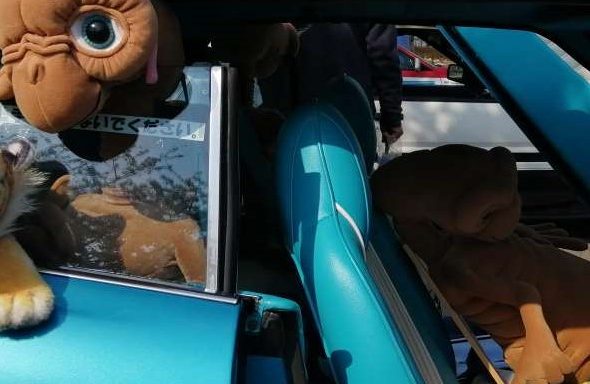
In the 90’s and 00’s car tuning and car collecting hit its peak. The Japanese way of car tuning and customization became a worldwide phenomenon. Most people might remember the movie Fast & Furious: Tokyo Drift from 2006, which was made upon the hype. The ones, who remember this movie, can recall how the tuning scene looks like and how the underground environment played out. The history With world-famous brands such as Nissan, Toyota, Mitsubishi, Honda, Lexus, Mazda and Daihatsu, Japan is a car manufacture country. Some of the country’s economy is built up around cars, which have had a huge impact to people of Japan. After the war Japanese men started to tune their cars, which escalated to the huge trend and obsession, that it became. In the late 80’s the trend was about to enter its prime. In 1989 the /Midnight club /was established, which was a very exclusive car club for enthusiasts of car tuning. The club arranges meetups and races, which was the main purpose of car tuning The obsession Japan has a word called otaku, which translates to nerd, geek and enthusiast. Otaku is more of a culture than a word, which applies to these car enthusiasts. The Japanese culture is very much competitive, and kids are taught from a young age about being the best and winning. This cultural dimension also applies to the car environment, where everyone involved want to have the fastest, coolest and most admirable car. There are different aspects of tuning and customization. Some like to buy vintage cars and rebuild them after their taste, while others have the latest Porsche or Lamborghini. Japanese car manufactures have through time created some iconic cars within this environment. If I mention cars like Skyline, Supra and RX-7, you can properly recall, who the manufacture is, and what it looks like. At the same time some Japanese people are not tuning and customizing to show off, but simple for their own amusement. They often collect antique cars, bring them to their garage and just simply make them look nice. Maybe if the cars are beyond nice, they bring it to one of the very popular car exhibits. The supercar-era Street racing and tuning peaking in the 00’s and kind of died out in the start of the 10’s due to improvement of police effort. The police brought more attention to the issue of street racing by bringing more officers on the street and step up their own car collection. For instance, they started using Nissan GTRs as police cars. In that way they could keep up with the racers. For some years there was an empty unfilled space in the car community. At the same time the racers from the 90’s and 00’s had become older and lost their interest in dangerous street racing. Therefore, a natural change happened, where the streets took quiet and the racers as well. As far as I am concerned the streets are still quiet, but the obsession with cars are not. The culture has just changed to a more radical self. With that being said some of the streets of Tokyo are still buzzing with noise from supercars. Rich people are still showing of their million-dollar cars. Take a walk in the wealthier area of Tokyo and the supercars will be driving by you constantly. Especially the areas Roppongi, Omotosando and Daikanyama are filled up due to the residencies of wealthy people. Don’t be surprised if the next three cars passing by you is a Ferrari, Porsche and Lamborghini. Showing off Showing off properly is a bold way to put it, but Japan have numerous car exhibitions every year. The biggest one is called /Tokyo Motor Show /and is held on Odaiba in Tokyo. Here is a list of exhibitions and locations: Tokyo: * Tokyo Auto Salon, Makuhari Messe, January * Automotive World, Tokyo Big Sight, January * Tokyo Motor Show, Tokyo Big Sight, October * Toyota City Showcase, Mega Web Odaiba, All year Nagoya: * Automotive World, Port Messe Nagoya, September * Nagoya Auto Trend, Port Messe Nagoya, February Osaka: * Osaka Automesse, Intex Osaka, February * Osaka Motor Show, Intex Osaka, December
Henry K. (18) from Germany lived the ultimate Japan experience: residing on the rural island Sado surrounded by locals and working in a small restaurant/bar that specializes in Yakitori, grilled chicken skewers. Three months after his job ended, we interviewed him about his tasks, his activities aside from work and the ups and downs of living in the countryside. Henry, when had you started the job and what were your general working hours? I started in early December 2019. At the beginning I was planning on working there for 2 months, which I thought was a bit too short, as I heard that most Japanese employers prefer their staff to work for a minimum of three months. But luckily I was hired anyway. In the end I stayed for two more weeks than originally planned though, because I was in charge of training the new employee that came after me. Generally I worked five hours per day, five days per week, Tuesday through Saturday, having Sunday and Monday off. My shifts started at 17:00 and ended, depending on how busy the bar was, around 22:00. Sometimes I stayed longer, if guests were still there to be catered for. What did a typical shift look like? What were your tasks? My boss, the owner and cook of the Yakitori bar, met me in front of my apartment and together we went and picked up the chicken skewers from a restaurant that prepared them for our bar and that was conveniently located in the same building as my apartment. Then we drove to the bar and started our preparations in order to open at 17:00. Preparing meant for example to check the reservations of the day and arrange the spaces for the guests. Once the guests arrived, my tasks were to offer them a seat, take orders, serve drinks and food. The breaks, when all guests were served, I used to wash dishes or to talk to the guests. It was only me and my boss working in the small bar. He was the main cook, but I helped out in the kitchen, too, as much as I could. The evenings ended when all guests were gone, which sometimes could be long after official closing time, for example when a nomikai (drinking party) was too good to leave, and we cleaned and tidied up the bar, kitchen, stored the dishes where they belonged and took down the noren (a kind of curtain that is hanging above the door of traditional Japanese restaurants or shops). What did you do in your free time? Sado can be quite cold in winter, and when I was there it was raining often, so aside from the most famous must-see spots I haven’t been traveling too far around the island. I rather concentrated on exploring the area I was living in. Sometimes there were concerts to visit. And I also joined the local karate club. I tried to make the most of my free time, even if I was often alone, at least at the beginning. How did your Japanese skills improve while living and working in Sado? Extremely! I could already understand quite an amount of Japanese before I went to Sado. Otherwise I wouldn’t have landed the job in the first place. But during my time I improved immensely, because I was surrounded by Japanese locals non-stop and was “forced” to understand and speak the language. Non-English speaking Japanese guests were gathering in the bar every night, having me already socially interact in Japanese language almost daily. And aside from that my boss opened so many doors into the local community. He often invited me, in a very Japanese manner, for after-work drinks in other restaurants or to a karaoke joint, which became next to karate a beloved leisure activity of mine. Having exercised martial arts before. I felt grateful to be integrated into the local karate club. Being only the two of us and being in almost daily contact with my boss, we got very close and he even invited me to spend Christmas and New Year’s Eve with his family. It was such a wonderful experience and one of my Sado-Highlights. I am grateful for everything my boss did to me. All that helped and shaped my Japanese skills more than I had ever hoped. How did you like the job? The work itself was really enjoyable. As mentioned, I got along with my boss and I never had any negative experiences with the guests. It was always positive and funny. Even in shifts that were harder than others I still could manage to work dedicated. Although I have to admit that the working hours need time to get used to. Starting your work day at 17:00 and ending it only shortly before midnight, followed by a couple hours of socializing, might be hard on some people. But I did it with pleasure, especially because it expanded and maintained my contacts with the locals. The only real negative point was that smoking was allowed in the bar, which I don’t like. That couldn’t be helped though, as until recently that was the norm in most Japanese bars. How did you originally find the job? It was always my goal to discover various sides of Japan instead of staying in one place for too long, so moving to the countryside at some point during my Working Holiday was a must. I saw an advertisement poster of the Sado Island Tourism association hanging in the hallway of the Tokyo share house that I lived in during my first few months in Japan. I found out that World Unite!, who is running the share house, is partnered with Sado and inquired about possible jobs on the island with one of the staff members. After a job interview by phone with the bar owner I was hired. The interview was in Japanese, but the World Unite! staff member was luckily in Sado at the time and could sit next to the owner in order to help us communicate in case it was needed. May I ask what you earned during your time in Sado? The hourly wage was 830 JPY. That doesn’t sound much compared to wages in Tokyo, but first of all rural Sado of course has, understandably, a lower minimum wage. And second of all the rent of my apartment was 10,000 JPY only, therefore very reasonable. And in a town as small as the one I was living in there is not a lot of money to spend, so it was more than enough to live. I was lucky to get such a good deal on the 2 rooms apartment, as it belonged to my boss. The hours I worked I was allowed to write down at the end of each shift independently. Thanks for the interview, Henry! Could you give possible future Working Holidayers some advice? Of course! There are some basic things that you should prepare for when coming to Japan and especially if you are planning to work on the Japanese countryside. The most important thing to work out are some basic Japanese skills. I was lucky that my boss could understand and speak some English as he spent some time overseas. But if I hadn’t studied a little of Japanese before starting the job, I think I would have had a hard time. Also because most guests only spoke Japanese. If you want to be part of the local community, I recommend to reach at least N4 level [on the Japanese-Language Proficiency Test scale], meaning you have the ability to understand basic Japanese. Even though I had that level once I first came to Sado and started working, I felt a little left out at the beginning. I was not yet integrated, did not have a proper routine, and I only had real social interaction during my 5 hours shifts at the bar. This can be a little frightening, but you need to get over it and take the initiative and courage to make the most out of your stay by putting yourself out there. Even if it feels like you were the only foreigner on the island. Being open minded and in for every opportunity that people you get to know want to give you is so important. My last recommendation would be to not spend your Working Holiday in only one place. I’m doing a Working Holiday here to get to know Japanese people, culture and different parts of the country. As ensuring it might have been spending the first few months of my stay in a sharehouse in Tokyo with fellow English and German speaking Working Holidayers, the repetitive it was. Travel to rather unknown places and emerge yourself in the culture if you want to turn your Working Holiday into something valuable for your life.
We met with Felix M. (19) just a few days after his last shift at a Tokyo located logistic company for educational books. The German worked there for a little over 3 months and was so nice to give us an insight into his Working Holiday job. Felix, how did a typical work day look like for you? The company I worked for receives, depending on the season, huge amounts of deliveries from printing groups every day. The packages contain mainly educational books that I needed to unpack and sort into their respective space in the shelves of the storage room, first thing in the morning. Throughout the day my main task was to put our clients’ orders together, meaning, searching for the books they ordered, putting them into packages and making them ready for pickup from the delivery service. I had to be fit in order to lift the boxes, but that was not a problem, as I had done more physically challenging work back in Germany. How did you like the experience? The work itself was easy and almost monotonous I have to admit. But the work environment was all the better! The people who worked there were all friendly and we got along well, which made the job really enjoyable. The general company language was English. That made things easier because I barely speak Japanese. All in all it was pleasant to work there. Did you need any Japanese skills for the job? No, it was completely doable in English. The only times Japanese skills would have been helpful was when I had to accept the deliveries from the Japanese post service at the beginning of each day. Or when I wanted to know the meaning or reading of a Kanji. But my boss just quickly taught me if needed, although that rarely happened. Consequently my little existing Japanese didn’t improve at all during work. That was honestly the only downside of the job. How did you find the job in the first place? One of the World Unite! staff members who is acquainted with my boss posted an advertisement for the job in one of the organization's chat groups. I just had to send my application documents, in either English or German, because my boss was German actually, to her. She forwarded it to my future employer then. He found interest in me and invited me to a job interview. I was hired and a job training followed during the first couple of weeks. What were your general working hours? I started every day at 10:00 and most days I worked around 4-7 hours, depending on how busy we were. The months I worked there (beginning of February to mid May 2020) were rather busy, one of the reasons I was hired in the first place. That’s because school starts here in Japan and other places in April and educational books need to be distributed. So in average I think I worked around 4-5 hours a day, 7 hours on busy days, from Monday to Friday. One single time I also came in on the weekend because there was just a lot to do. 7 hours a day, 5 times a week, that sounds almost like a full time job. I assume you earned enough to make a living? And did that leave you with enough time for private activities? Definitely! On the weekend or even after work I had enough time to either meet friends or go to the gym. I earned 1,200 JPY per hour, minus tax, which was enough to live. And my working hours left me with plenty of free time. It was pleasant and suited my lifestyle. And there was a big plus coming with the job. Most employers in Japan pay for their employees' commuting fee. So did mine. As I worked there 5 days a week, I received a commuter pass. With that I could travel between the train station I live close to and the station close to my work place for free, whenever I wanted. Even on the weekend. Meaning, I saved a lot of money when going to Shibuya, Shinjuku and so on during my free time, as the commuter pass covered those spots. What are you planning on doing now that your job is over? Last Friday I had my very last shift. It was a nice experience to get to know my colleagues. But now I’m looking forward to traveling around, because I have spent most of my Working Holiday in Tokyo so far. I have to be back in Germany by the end of August to attend an interview with a university to get into my chosen major computer science. So I want to use the time I have left in Japan the best I can. Any advice for people who are thinking about doing a Working Holiday in Japan? Just do it! Come to Tokyo. It’s a massive city, there are always jobs waiting for us Working Holidayers. I wouldn’t worry about that.
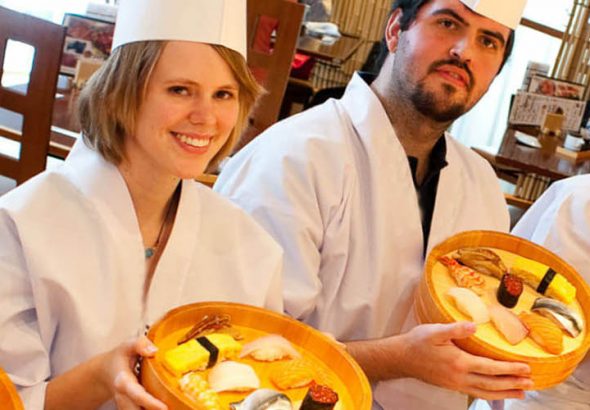
If you want to learn how to prepare Japanese dishes such as Sushi, Tempura, Ramen, Udon, Bento, Soba, Wagashi (Desserts) or even learn the art of the Japanese tea ceremony, we recommend airKitchen, a website where local private hosts, but also restaurants with master chefs, offer cooking lesson to foreigners. The costs start usually from around 3000 JPY for a 1.5 to 2 hours course including the ingredients, but there are even cheaper listings. Lessons can however also reach 24,000 JPY or more for a 2 hours class taught by a master sushi chef. Lessons on airKitchen are listed in Tokyo, Kyoto, Osaka, Sapporo and many other cities in Japan. https://airkitchen.me
Living in the Japanese countryside If during your Working Holiday in Japan you want to get to know the traditional Japanese countryside with people who have a strong sense of community and are deeply rooted in their traditions, try Sado Island. Sado, after the main islands of Hokkaido, Honshu, Kyushu, Shikoku and Okinawa, is Japan's six largest island. When gold was found on Sado Island in 1601, the island flourished economically and culturally, developing a unique and rich cultural heritage, including performing arts such as dance, chants and music, the world-famous Taiko drumming, puppet theater, folklore festivals, and traditional handcraft. Sado has hundreds of Buddhist temples, Shinto shrines and several historical villages from Edo Period (1603-1867), which have remained architecturally mostly intact. The island is of extreme scenic natural beauty, with 288 km of rocky coastline, dense forests, terraced ricefields and a northern and southern mountain range reaching an altitude of 1172 meters. Sado is sparsely populated, with the vast majority of the population of around 55,000 living in Sado City in the flat middle part of the island. You can find all infrastructure there that you can expect from a Japanese city of that size. As opposed to large cities such as Tokyo, you will find it easy to get in contact with the population, as the people of Sado are very community-oriented and interested in their fellows. Which Working Holiday Jobs are there on Sado Island? Working Holiday jobs mostly exist in the island's 3 main economic sectors, which are tourism/gastronomy, farming and fishing. Jobs in tourism/gastronomy include employment in ryokans, hotels, restaurants and with tourism activity providers. Most opportunities for tourism-related jobs exist during the summer months from May to October. The agricultural produce most typical for Sado are rice and persimons and helpers are usually needed during the planting and harvesting seasons, which are April/May and September/October. Fishery jobs exist throughout the year. Particularly for oysters and mussels the season is during the winter months. While for some jobs, Japanese language skills are required, they might not be necessary for others. As you might struggle arranging a Working Holiday job in the countryside on your own, World Unite! offers support services on Sado Island. They provide for instance English training about how to harvest and classify persimons, which will make non-Japanese speakers employable even by farmers who can only give you instructions in Japanese. What else can I experience on a trip to Sado? You can travel from Niigata to Sado using a Boing 929 Jetfoil. The jetfoil is basically "an airplane on the water", which gets the dynamic lift from sea water instead of air. While the wings are under the water, the passenger cabin is floating on top of the water surface, easily reaching speeds of around 80 km/h.
Two new nationalities for which there will be a Working Holiday Visa for Japan from 2020 are Dutch and Swedish. For citizens of the Netherlands, it has been announced by the Dutch Embassy in Japan that the visa can be applied for from April 2020 by Dutch citizens aged 18-30 years (by the time when applying for the visa). 200 Working Holiday visas will be issued in the Netherlands per year. For citizens of Sweden, the official date for the launch has not been published. Unofficial sources have stated March 1st, 2020 though. Most likely there will not be any limit of the total number of visas issued. The Working Holiday Visa allows its holder to stay in Japan for one year and not only to travel around and get to know the country, but also to accept employment to be able to fund your time in Japan. World Unite! offers Working Holiday support services in Japan. The list of countries for which there is a Working Holiday Visa for Japan now includes Sweden, Netherlands, UK, Ireland, Germany, Austria, Australia, New Zealand, Canada, France, Denmark, Norway, Iceland, Portugal, Spain, Hungary, Poland, Slowakia, Czech Republic, Lithuania, Argentina, Chile, Korea, Taiwan and Hong Kong.

Amongst those doing a Working Holiday in Japan, there are many common misconceptions and myths about Working Holidays in Japan. These might result from outdated information found on the internet, or from misinterpretation of official texts. The wrong information is then passed from one person doing Working Holidays to another. But don't worry - this article will bust some of these myths! Myth 1: On a Working Holiday Visa it is not allowed to work at bars It is perfectly legal to work at bars, as long as they are "normal bars" that are just selling drinks and not offering any services which are "against the public morals of Japan". Businesses which are "against the public morals" include for instance gambling, the sex industry and hostess clubs. At such places it is totally illegal, if you are on a Working Holiday visa, to do any kind of work, even if it's not directly as a hostess, prostitute or as gambling service provider. E.g. being a cleaner or a dishwasher at any such establishment is illegal and will certainly result in a fine and deportation, should the police or immigration officers find you working at such establishment. "Hostess Clubs" are places where usually no sexual services are offered, but there are hostesses engaging in typically flirtatious conversations and providing other entertainment such as singing karaoke with male customers who are paying high prices for drinks. On a first glance, it is not always very obvious for people unfamiliar with such establishments whether a place is a "normal bar" or a "Hostess Club". If you are invited to a job interview or offered a job at a bar, you should have an in-depth look at the kind of customers and other employees it has, and in doubt reject the job. Also, don't easily trust employers running such places who might tell you that the job is perfectly legal for you, which might not be true, either because they don't know about the restrictions of a Working Holiday Visa, or they don't care. There are also so-called "Host Clubs", which are the equivalent for female customers, employing male hosts. It is of course also illegal to work at such place. Jobs at "Maid Cafés" (and the equivalent for male customers called "Butler Cafés") are generally allowed, as long as they only sell beverages and food and the services offered don't resemble those of a "hostess" or "host" club. Myth 2: On a Working Holiday Visa you are only allowed to do part-time work There is no limitation of the amount of hours you are allowed to work on a Working Holiday Visa. Some employers confuse the Working Holiday Visa with a Student Visa, which has a limitation of 28 hours of work allowed per week. Myth 3: If you want to leave Japan during the validity of your Working Holiday Visa and you wish to return and continue your Working Holiday, you must go to the immigration office and apply for a Re-entry permit This information is outdated. Since 2012, if you want to leave Japan during the validity of your Working Holiday visa and you plan to return, at the immigration counters of the airport, when you are leaving, you just have to fill a white form that you find there called "Embarkation card for reentrant". You should mark the box "I am leaving Japan temporarily and will return". The immigation officer will then staple another card into your passport called "Disembarkation card for reentrant". When you return to Japan during the validity of your Working Holiday Visa, at the immigration counters of the airport you should go to the counter which says "Special Re-Entry Permit Holders" where you show your passport with the filled-out Disembarkation card and your Residence Card, and you are allowed to enter and continue your Working Holiday. Myth 4: You need a person of reference and guarantor in Japan to get a Working Holiday Visa You don't need a reference and guarantor in Japan, but you can leave those fields blank in the visa application form. Myth 5: Everyone who has a Working Holiday Visa for Japan can get free Japanese language lessons This is not true and we don't really know the origin of this myth. There are Community Centres at every city and town in Japan that offer inexpensive (and at some cities even free) Japanese language lessons to foreigners. For some (but not all) cities it is required to be a Resident in Japan to join these lessons. If you hold a Working Holiday Visa, you are a resident, so you can join these lessons, but there are not generally free. Myth 6: During your Working Holiday, you can travel around Japan cheaply using a Japan Rail Pass for discounted train rides The Japan Rail Pass for discounted train tickets can only be purchased by tourists. Tourists are people who have either a Temporary Visitor Status (for those nationals for whom there is an exemption of Visa for short-time stays in Japan) or a Tourist Visa (for those nationals who need to apply for a tourist visa prior to their trip to Japan). If you hold a Working Holiday Visa, you are not a tourist, but a resident and therefore you cannot buy the Japan Rail Pass. Myth 7: Accommodation-wise, it is the cheapest and best option to rent your own apartment in Japan (that you might share with friends you make in Japan who are also on a Working Holiday visa) Particularly in central locations of Tokyo, where there is a very high demand for apartments, landlords can choose between many people willing to rent an apartment. They will most likely not choose a foreigner who will stay for a maximum of one year and doesn't have a permanent employment contract. In addition, almost all rental apartments are offered through real estate agents that usually charge a fee of 3 months of rent to the tennant, and many apartments come unfurnished. The most feasible accommodation option for foreigners who are in Japan on a Working Holiday visa are the so-called "Share Houses". Myth 8: It is the best option to rent a portable wifi device at the airport to have internet access in Japan Renting a portable wifi probably only makes sense if you come to Japan for a few days only. For anyone staying longer than that, the cheapest option is to get a Japanese SIM card for your mobile phone. For stays of up to 90 days the choice would be a pre-paid Travel SIM Card, and for longer stays to make a phone contract with a Japanese mobile phone provider. If you have a support package of World Unite! for your Working Holiday or internship in Japan, they will make arrangements for the best mobile phone/internet access option for you. Myth 9: You can get a tax refund when leaving Japan for the income tax that your employer has paid for you You cannot get back the income tax that your employer has paid for you in Japan when you leave Japan after your Working Holiday. If you have done any pension funds payments in Japan you can get them back when you leave Japan. It is however unlikely that Pension Funds payments were made for you by your employer as this is not a requirement for employees who are on a Working Holiday Visa. -- This article was written by Chris Engler, founder of World Unite Japan KK, a company based in Tokyo, providing Working Holiday support services to currently more than 1000 young travellers per year in Japan. You can learn more about World Unite!'s Working Holiday support services in Tokyo.
The next Olympic summer games will take place in 2020 in Tokyo, Japan. The application process for Olympic volunteers was accomplished in December 2018 for around 80,000 “Game Volunteers”, which are needed for guidance, events, mobility support, personal support, operational support, healthcare, technology, media, and ceremonies, along with around 30,000 “City Volunteers”, providing transportation information to tourists and acting as guides. Also Neha, 26, from the UK, has applied and is currently waiting for an invitation to the 2nd stage of the selection process. Neha had already volunteered at the London 2012 games. We have met her in Tokyo and have asked her about her experiences in London. Why did you want to become an Olympic Volunteer? I wasn't sure initially, but my teacher at the time told me that I should try. And I thought, if I get in, that would be fun. And I got the job and I was so excited. The whole process was so exciting because I was just telling everybody: “I'm going to be a volunteer for the Olympics” - and what are the chances that you can ever say that? Also on the resume it looks very good. If in an interview they ask you what else you've done and you can say: 'Ah yes, I've volunteered at the Olympics', it makes you stand out and it makes you interesting. After having volunteered in London in 2012, I wanted to apply again for the 2020 Olympics in Tokyo. How did you become an Olympic Volunteer? Basically, in order to volunteer for Olympics, you have to apply two years in advance. You can apply online, on the official website, by downloading some documents that you send them online. Then you wait for them to reply. I think it took like six months for them to reply. Then I had passed the first application stage. Then I had to go to a one-to-one interview. How was the interview? It was fairly casual, they just wanted to know why I applied, what my preferences are and what time I would be available to do the job or if I'm fine working the whole week during the Olympics. What happened after the interview? After that they kept updating me on what was happening with the events. When they confirmed that I got the position as a volunteer, it went quiet until around two months before the Olympics. So they called me back again because I had to let them know what my size is. Why did they want to know your size? For the uniform, jacket, shoes etc. that you have to wear as a volunteer. They give volunteers everything. You get the oyster card as well, I kept it as a souvenir. During the Olympic weeks, you were able to use it wherever you go, it was free of charge. All the trains I took didn't cost me anything, so I could get everywhere on time. They gave me everything, my entire uniform, jacket, shirt, trousers, shoes and caps. Everything I got was free, even the little notebook, it was so fun. Were you able to decide at which venue you were positioned? I had to give my top three preferences at which venue I wanted to work. At that time I loved watching tennis, so my first choice was tennis, second was swimming and third was the race track. I got the tennis one and it was so much fun. How did the preparation process continue? Two weeks before it started there was a welcoming party for all volunteers. It was in the Wimbledon arena. We were all there, it was so crowded. It was all of the volunteers and events welcoming everybody, it was so much fun. What was your actual work at the Olympics? I had to show people the way, where they wanted to go. Whatever questions they had, when people were lost or anything, I showed them the way to events they wanted to see or other venues they wanted to go to. I would let them know which trains they could take to go to all the venues. I had a timetable that I could access online. I think I worked five to six days a week. It's not very complicated. They explained me everything, gave me the map, and a plan for emergency situations. What did you enjoy the most about being a volunteer? I think the best part was, when I was done with the shift, I could go and watch the games for free. That's how I got to watch the tennis men's finals. All the players I've seen on TV I saw in person. I saw Serena Williams and I saw Andy Murray. He even waved at us. The whole experience is so much worth it, you get to meet so many people and they're all so nice, even the spectators. The London games were at an English-speaking country, obviously, so I was thinking here in Japan, they will definitely need a lot of English speakers to help them out. What did you like most about the whole experience? I got to meet so many people from different countries but also the volunteers were really diverse. There were elderly people volunteering, and also young students. Age-wise it was very diverse. There were a lot of people from different cultures and obviously you get to watch the Olympic games for free. I also got free food. Were you paid for any of the work? No, I didn't get paid. But I got all this free stuff, I got the whole uniform. I still have it in my room. I even still have the water bottle, the pens and notebook, even my ID card, but the best was the oyster card. It says Olympic 2012. So I can keep it as a souvenir. What would you say to people who want to apply? Definitely go for it, it's a once in a lifetime chance. It's Olympics, it's the best, so many people watch Olympics, I grew up watching it. Everyone is participating and that is the fun part of it. Working Holiday opportunities during the Tokyo Olympics 2020 While the official application period for Olympic volunteers has already been closed, throughout spring and summer 2020 Tokyo expects a strong increase in foreign tourist numbers. Thus, the Olympic Games prove to be a great opportunity for those coming to Japan on a Working Holiday vsa, as there will be more demand for staff who can communicate in foreign languages, particularly in the tourism, hospitality and service sectors. Many restaurants in Tokyo are not prepared to cater to foreign customers and the language barrier is an issue the industry is well aware of. Thus, restaurants will need a large number of foreign-language staff able to communicate with foreign tourists who have little to no Japanese skills while visiting the country. The same is true to hotels and other accommodation providers. Also the tourism industry will be in need of people with foreign language skills to work as guides, interpreters and translators. More generally, in Tokyo, shops of all kinds might increase staff numbers during the spring and summer of 2020, adding staff with foreign-language skills. Job opportunities related to the Olympics 2020 might arise even from now on when businesses get prepared to market to the foreign visitors for the 2020 season. World Unite! offers Working Holiday support services in Tokyo.
Japan will host the 2019 Rugby World Cup, which will be held at 20 venues across Japan, from September 20, to November 2, 2019. The Rugby World Cup 2019 Organising Committee is expecting 4.5 million tickets to be sold, making the first Rugby World Cup in Asia also the highest popular attended one of all times. The recruitment of official Rugby World Cup volunteers has already been closed, with 10,000 volunteers chosen out of 38,000 applicants during the official 5 days application period in December 2018. However, if you are a Rugby enthusiast and you want to be close to where the World Cup action is, why not come to Japan on a Working Holiday Visa and get a fully paid position in Tokyo or another city in Japan where matches are carried out? It is estimated that around 25,000 people will be additionally hired during the World Cup, providing services to the around 400,000 foreign visitors that are expected to attend the cup, staying for an average of 14 days. So if you speak English or other foreign languages, there will be excellent employment opportunities in sectors such as hospitality, restaurants, transportation and tourism services. On a Working Holiday Visa you can stay for a maximum of 12 months in Japan (Australians even up to 18 months), so if you enjoy huge sports events, you might still be in Japan during the 2020 Tokyo Olympics (July 24 to August 9, 2020), which will offer similar employment opportunities. World Unite! offers Working Holiday support services in Japan. Title Picture: Jolon Penna, Creative Commons License
Markus B. (19) from Germany tells us about his experience working for a sugar cane farm on the small island of Miyakojima, roughly 300 kilometers away from Okinawa main island. He arrived to Miyakojima on May 26th and worked there for a month. With a smile he looks back at his extraordinary experience in the very south of Japan. What was the farm like? (laughs) Funny enough, I actually worked for some sort of Japanese Buddhist cult. I learned that they send the sugar cane harvest to their Buddhist headquarters, which is located near Osaka. Apparently they collect harvest and other goods from all sorts of places all over Japan and then sell it elsewhere. Every morning they'd also have like a morning prayer and at some point I had to join as well. But it sounds stranger than it was, the people were incredibly friendly and nice. I did some research and apparently there are a lot of peaceful Buddhist movements in Japan. Why did you want to do farm work? I wanted to live and work in Okinawa for a month, because I'd heard many good things about the island. So I contacted World Unite! and asked if it was possible to do farm work there. Eventually I got a job offer from a sugar cane plantation on Miyakojima and I thought: “Why not?”. So on May 26th I flew south. How did your typical working day look like? I'd wake up around 4:40am, take a shower and have breakfast. Then I'd talk to my housemates, pack my gear for the day and we'd leave for the fields, so that we could start at 6am. There were two shifts every day, the first was from 6am to 10am, and the second was from 3pm to 7pm. Like this, we would avoid the worst heat during the day. We would get around 40 degrees, which was tough. So every day was eight hours of work. What I did was basically chopping off sugar cane and making it ready for transport. You could roughly break it down into five steps. The first step was to tear off the leaves from the top. The second was to chop off the sugar cane right above the root. Third step was to collect all the sugar cane plants and pile them up on a heap. The fourth step would be to tear the last of the leaves off and the fifth step was to tie them together, so they were easier to transport. What did you earn during your time? I earned 4500 JPY a day (~35 EUR). However, I didn't have to pay for my accommodation nor for food. What would you do in your free time? During my free time I explored the island with my working colleagues, because many of them were there for the first time, too, just like me. Other than that I'd just relax and take it easy. Did your Japanese improve during your stay on the farm? Yes, definitely. Interestingly, my boss was kind of a Germany-fan, and he knew some words. And one co-worker could speak basic English. But aside from that they only used Japanese. My co-workers were all super friendly, also my boss was really cool. I'm still in contact with all of them. In general, all the people on the island were really nice, however it was also kind of funny and weird at the same time to be the only "white" person on the entire island. I was kind of an attraction for the people. Did you experience any low points during the time you worked on the farm? I have to admit, there was one. It was the first day, the day before my actual work started. It was hot in my room, I couldn't sleep and I knew I had to work outside in the heat the next day – that was when I was quite terrified of it all. But after that, it was fine and it all went well. But of course it was hard at first, and I discovered for myself that I don't want to become a sugar cane farmer, at least for the long term. But at the same time I was glad that I'd done it. What would you tell people who are thinking about during farm work in Japan as well? I think people should be aware what they get themselves into. Farm work is hard, physical labour and people should be really sure that they want to do that. It is important to learn how to control or at least filter your thoughts. It sounds generic, but you have to keep thinking positively. If you have a positive mindset, you'll have the most amazing time. In terms of the beautiful island of Miyakojima, I'd say you should be aware that it is difficult to get off the island, especially if you can't drive or you don't have a car. I was glad my co-worker would give me lifts regularly, but aside from that there is hardly anything. You definitely can't rely on the public transport. Did this experience shape you as a person? I would definitely say that this experience taught me new ways of thinking. The people on the island were insanely nice. They lead simple lives, but they are so genuinely happy and content, and I think I kind of absorbed some of that attitude. The people are always in a good mood and happy, and it really rubbed off on me. You learn to appreciate the little things, it all really inspired me. What do you do now? I arrived in Osaka on July 9th. I'm working in a guest house and izakaya, and I also live there. I'm thinking of working here for at least another month and after that, I'm not sure yet. But I'm thinking of staying in Osaka. My visa expires on April 18th, and I want to stay in Japan the entire 12 months that the Working Holiday Visa provides me. " order_by="sortorder" order_direction="ASC" returns="included" maximum_entity_count="500"]
Many people are into second hand clothes shopping: It's cheap, it's original, and it is often something you do not see everyone else wearing! Especially as a Working Holiday participant, you might want to spend money on travelling instead of expensive clothes, so we found a place where this is possible. Hipster of Tokyo If you like affordable clothes, then why not try out second hand shopping? In Tokyo, the neighbourhood Shimokitazawa is known for it's many second hand shops, cafés, and young hipster people. It is also known for live music and theater. So on a sunny Saturday, my roommate and I decided to find this place. The way there is very easy: A walk from the World Unite! share house to Kiba station, then 2 different trains, and we had arrived to Shimokitazawa station. Then we basically just walked out of the station, and were met by several second hand shops, good smells of sweets and coffee shops, and a great deal of people. We chose a random street, and then we started looking around. There was a mix of second hand shops and "normal" shops, cafes, restaurants, convenient stores etc. We went into different shops, and could see the originality of the clothes, and also how different it was to what is usually seen in the streets of - for example Kiba, where most people only wear black, white and grey. So far we could already tell that the place is perfect for people who like fashion! Colours, colours, and more colours We went past so many shops, and found a dress shop that we decided to check out. The amount of different colours were outstanding! I was wondering how people could possibly wear such flowered and coloured dresses, but it actually looks really good on many people here. In the streets we also saw people wearing original outfits, but most of the people walking in the streets did not look specifically hipster. After walking a lot, we decided to take a break at a crepe cafe. Everything was baby pink inside the cafe. A friendly male cashier greeted us when we came in, we ordered our chocolate crepes, and then we realised that all the customers were female. It was like a little girlie spot, with a beautiful lamp, small pretty details, and best of all - the smell of freshly made crepes. The place was so cozy and people looked to enjoy a lot. New York Joe Exchange One "Must-Visit" second hand shop is the New York Joe Exchange. We went there, and the place was packed! People were standing in line to look at all the colourful hipster clothes, and the line to the fitting room was long! Also, there was loud rap music and people seemed so excited to shop there. That is a place that no one who visits Shimokitazawa should miss! Sadly, we did not find anything we wanted to buy, but it will probably be a better idea to visit the shop on a weekday, and not on a busy Sunday. But it was nice to see, and we were happy that we went there. That was the last stop at our little day trip to Shimokitazawa, and we went home with yet another experience. About the Author Christina is 26 years old, originally Kenyan/Danish and she is currently interning for World Unite! in the Japan Tokyo Office. She is helping participants who do a Working Holiday in Japan through World Unite!, and when she is in the office she helps out with administrative work and social media marketing. Title picture: Guwashi99; creative commons.
Japan sure has many things to offer! Everything from manga and anime, to robots and mountains! Have you for example ever heard of a 599,15m high mountain one hour away from Tokyo? I sure had not, but then someone from my World Unite! sharehouse talked about his great hike on Mount Takao. So - that is basically how that idea was planted in my head! Step 1: Find the Mountain! I am staying at the World Unite! sharehouse in Tokyo - now it is my second month here, and every weekend I do my best to plan the most interesting things to do! I do not mind if it is being touristy, as I will only be staying here for 3 months, so I do not see myself as anything else than a tourist! I just want it to be fun and exciting. So, last weekend the menu was: A mountain climb! My World Unite! sharehouse roommate and I wanted to climb Mount Takao, so we packed our bags with water and food, charged phones, good mood, and we were ready to go. From our sharehouse in Shiohama to Takao Station took approximately 2 hours, with a little train confusion on the way - but we made it! The day was hot and humid like many other days during the late Japanese spring, so we were happy and ready to explore a nice and cooler area in Kanto! When we finally arrived, my roommate did not feel very well so we decided to split up. My roommate explored the area around Mount Takao, and I climbed it. Usually, I am not a big fan of doing things all by myself as I actually really enjoy experiencing with friends or family, because then you can share the experience afterwards, and create memories together that way! But that day I was on my own! Of course, I had my very best friend in Japan with me, Google Maps, that (again) did a good job in supporting me. So, let me just admit it: the hardest thing on this little trip was to find the mountain. Where should I start? Google Maps showed me that it would take around 2 hours to get to the top, so I just started to follow the blue dot, and I ended up in a place with music and lots of people - and a path! So it looked like I found the way up. Step 2: Climb it So now you are probably thinking: 599.15 m, that is just a small hill - and now is the time I will advise you to google Mount Takao. It is an actual mountain, and it was an actual climb to the top! As I had finally found the path up, the next step was just to climb it. So I started walking comfortably up, and weirdly enough, most people were walking down. But as I looked behind me I could see that I was not the only one climbing it, so I could not be totally lost! I walked and walked and it was so so steep! I was even sweating and I was very happy that I brought a bottle of water. The place was beautiful though - so much nature! I could hear birds singing, the wind in the trees, and I could look up and see the sky which was totally blue. I was feeling very happy, and I did not have to worry about getting lost, because as long as I was walking up, I would reach the top at some point. So I continued walking, continued sweating, and continued enjoying! After some time, I reached a viewpoint from where I could see all over Tokyo - it was so beautiful! I met a nice American couple and asked them to take a photo of me, and then of course I took one of them. They were so friendly, and told me that they were living in Tokyo and then they wished me a good stay in Japan, and we went our separate ways. I decided to take a little break, eat some lunch, and enjoy the view, and then I continued up. Step 3: Yakuoin Soon enough, I reached this beautiful Buddhist temple called Yakuoin. It was so nice and there were many people there. I walked around, looked at people, and took everything in, as it was probably a once-in-a-life experience to be there (except that I had to pass the place when going down again, minor detail)! I had read that many people visit the temple to pray to the Buddhist mountain gods, and I could also see some people praying when I was there. After exploring the temple I continued further up, and there were lots of stairs to ascend. I did not want to be slow, so I passed many couples enjoying a climb, old people taking a walk, and also other tourists like myself. The funniest thing I saw was a lady who was taking her rabbit for a walk. Yes, you read that correctly, it was a rabbit. And no, it was not a small dog that I thought was a rabbit! It was an actual rabbit, and she had it on a leash and then she was carrying a little basket - probably so the rabbit could be carried if it felt tired. Of course, there were also people walking with their dogs in baby carriages (I guess it should be called dog carriages?), but I got used to seeing those in Tokyo by now! Step 4: All the way up Finally, I saw a sign saying "Top of Mt. Takao", and I knew I was close. Just a few more stairs, and then I was there! I walked to another viewpoint and it was so so amazing. That was one of those views that a photo just cannot catch! It was something you simply have to experience for yourself. I was so happy that I made it there, and I just really needed to share it with someone. So I called my family back home, and I told them how amazing it was, and then I felt even happier after the talk. It was also here that I found a friendly-looking person who took a photo of me at the top. It was so cool! I spent some time there enjoying the feeling until I was ready to go down again. Step 5: Down The way down went so fast! It basically felt like squatting all the way down, because I really had to control my legs so they would not just start to run away from me. It felt funny, and it was actually almost as hard as going up - just in a different way! But I made it down in no time. I walked and walked, back to the station, where I met with my roommate again, and we decided to spend money on discount ice-cream which was 100% worth it. So, all in all that day was just amazing, and it was a very amazing experience! I will definitely recommend everyone coming to Japan to try to climb Mt Takao. Oh, and a little side note; I found out that there are actually much easier ways up that the way I chose! Apparently, the path I used to go up, was a hard one, and my sharehouse-mates told me that there are other paths - a lot less steep. Good to know! About the Author Christina is 26 years old, originally Kenyan/Danish and she is currently interning for World Unite! in the Japan Tokyo Office. She is helping participants who do a Working Holiday in Japan through World Unite!, and when she is in the office she helps out with administrative work and social media marketing.
A working holiday should not only be about work but also about discovering the country. There is so much to see and experience in Japan that you should not miss out on while you are here! We wanted to get out of Tokyo city life for a long weekend and it wasn't difficult to decide on Nikko. Only a 2-hour train ride away from Tokyo, this town in the hills makes for a perfect weekend getaway if you want to sniff some culture and be surrounded by nature. We booked the Turtle Inn Nikko Annex Hotel which is not too far from the train station with its own onsen (Japanese style hot spring), and after dropping off our luggage in the lobby and getting some good advice from the receptionist for our stay we headed out for our first lunch in Nikko. Of course we wanted to try yuba, a by-product of tofu production that is ubiquitous in Nikko, being a center of Buddhist activity since its foundation. We found this cute little udon noodle restaurant called Kanman Teahouse that served yuba as a side dish, perfect for our lunch. The yuba was very smooth and flavorful, and we loved the cold udon and tea with Japanese sweets that we got afterward. A good start of our weekend Our First Day: History and Beauty Then it was time to immerse ourselves in Japanese history. After passing through a foresty road with old jizo statues we headed to the Tamozawa Imperial Villa Memorial Park. Here you can walk around the huge Japanese style villa that used to be the vacation home of the imperial family. It's not just the house that breathes a quiet atmosphere, the garden also makes for a peaceful little stroll in a typical Japanese garden. If you come at the right time you can also see a very old Sakura tree bloom. This was the green oasis we were hoping to find when we left Tokyo! As a visit to Nikko is not complete without visiting its main shrine, the Toshogu, it was next on our list. As expected there were many tourists, foreign as well as Japanese, but we could also easily tell why this shrine complex is so popular. Its wood carvings are exquisite, there are so many beautiful little details that the buildings are like pieces of art. At several locations within the complex priests carried out Shinto rituals in order to bring fortune to the people, and stones on the ground were arranged to look like turtles to bring good luck. What most people don`t know is that it is worth it to walk the extra 1.5 kilometer up the hill on the east side of the temple. Here you can find the rarely visited Takio shrine in the middle of the woods, surrounded by small water streams. We enjoyed being away from the crowds and savored the silence. By the time we left the Takio shrine it was getting dark, meaning it was time to look for a place to eat because restaurants and even bars close early in Nikko (and other places outside the big cities in Japan for that matter). We decided on Bar de Nikko because of its good reviews on TripAdvisor, and we did not regret it. The food was delicious and nicely presented, and there was a large assortment of drinks available. It was open until 21.00, which is quite unique in this small town. In the evening we soaked in the hotel onsen with a nice view of the fast streaming river outside through a large window and went to bed early. The Second Day: Hiking and Nature One of the purposes of the trip was to get out there and take a long walk in a beautiful, natural area. We wanted to breathe some nice, fresh air in the spring sun! We took the bus to the Chuzenji lake, an area that used to be a popular place to vacation for foreigners as well as well-to-do Japanese people. As we were there late March it was still off-season and very quiet. We first stopped by the Kegon falls, we didn't pay the few hundred yen to go downstairs and see the waterfalls up close, but I would recommend doing it anyway because I later heard from others who have gone down there that it was worth the money. We then walked almost all the way along the northern shore of the lake, which was great as we barely saw anyone else as soon as we left the little town. It was peaceful and quiet, and we walked around 4 kilometers before we got to the boathouse where we were surprised to find the restaurant open. Of course we were the only customers, but the noodles (yes, again as they are so good here in Nikko) were tasty and we were ready to go again. As we went more inland the road went up, and after 2 kilometers or so we hit a trail up Mt. Takayama. Feeling adventurous we went in even though the sign warned us of bears and deers, the former scaring us a bit more than the latter. But the trail was snowy, and after taking a selfie of the 'courageous us' and the snow we decided to turn around and go find the Ryuzu Falls which we came here to find. We soon found fast streaming clear water and went down the trail to see a cute tea house overlooking the falls which are named after the dragon it resembles. They served delicious ice-cream with the flavor of, you guessed it, yuba. It might be a surprising flavor, but it was actually surprisingly good! We then took the bus back to the hotel and ended up having the most thrilling part of our trip, a ride down the Iroha slope. I'm sure the driver knows this road like the back of his hand, but sitting right behind him and seeing the bus steer dangerously close to the slope's edge with a drop of a few hundred meters deep behind it about 20 times, made for a blood-curdling ride. I think Julia was very happy when we were back at 600 meters above sea level again instead of the over 1000 meters that we were above sea level before. After all this excitement we first went for a long soak in the hotel onsen again before we went out for dinner again. This time we went to a Chinese restaurant near the hotel that was almost completely full, a good sign. The food was indeed delicious, I would just stay away from the hot sake as I could tell why it was sold as hot sake instead of chilled or at room temperature. We then headed back to the hotel for some card games and our futons. The Last Day: A Temple and an Old Hotel After having a perfect brunch in the Kanaya Hotel Bakery (very much recommended) we first visited the museum right next door. Kanaya hotel was once the first hotel where Westerners could stay during the period in Japanese history when foreigners were still very rare in Japan and couldn't always stay in a regular Japanese hotel. The people who work there conduct short tours, most of them don't really speak English but it is still nice to hear a bit of simple explanation of what you see. Some parts of the hotel are original which is quite rare to see in Japan, especially in Tokyo as most buildings don't last this long here. We then went to our last stop on this trip, the Taiyu-in temple. What we loved here was that it was so much quieter than at the Toshogu, and it was a lot easier to relax and enjoy our surroundings. There was another mass blessing ceremony, and there were 4 beautifully colored statues near the main hall. For those who like wood sculptures, there was also a lot to see, as almost every animal was represented somewhere in the decorations on the walls. Some parts of this temple reminded me a bit of Persian or oriental art with the many colors and wood carvings. Also, we were not sure if we were supposed to go here, but a bit east of this temple up a hill there seems to be an abandoned temple with a vshery big statue in a closed off hall. There was almost no one there and it looked like no one was taking care of it, so it was a bit spooky over there. It was unfortunately already time to go home by the time we came back to the main road, but we didn't leave before a last bowl of noodles, ramen this time, and a Harajuku style desert near the station. If you are on a working holiday (or regular holiday for that matter) in the Tokyo area, you should definitely not skip Nikko. As they say in this locale: don't say 'kekkou' (I'm good) until you have been to Nikko! " order_by="sortorder" order_direction="ASC" returns="included" maximum_entity_count="500"] About the Author Stefanie has lived in Japan for 5 years, and is working as a coordinator for World Unite! since 2017. Together with her colleague Julia she decided to get out of Tokyo city life for a long weekend.
Most people who come to Tokyo know of the Skytree, the Tokyo Tower and the Shibuya Crossing with loyal Hachiko statue. Those are of course awesome places to visit when you are here, but how about some lesser-known but amazingly Japanese sights in the concrete jungle? Let me introduce to you these 5 quintessential Japanese scenes in the middle of Tokyo! 1. Bonsai Trees in Happo En This is one of the best places to see bonsai trees, as some of the trees that are on display here are already 500 years old! Pruned to perfection using traditional gardening techniques, these trees are more like masterpieces of art than anything else. Imagine all the work that went into a tiny tree that's hundreds of years old and grows exactly the way the bonsai expert wants it to grow. It is not a coincidence that an art that refined originated in partly Buddhist Japan. Besides the bonsai trees, the rest of the garden is also perfectly landscaped. It is no wonder that this is also a very popular place for young couples who can afford it to get married here and have their pictures taken in the garden. If you are lucky you might catch a few weddings and see what a bride and groom look like in their Shinto wedding dresses. They often pose near the pond full of happy and healthy koi fish. While you are there you should also not forget to stop by the tea house in the back of the garden and have a cup of matcha tea with some of the best Japanese sweets available in the city. The lady will serve you using Japanese-style small movements, where not one movement is unnecessary. Add to this the view, and you're all set for a perfect afternoon tea! 2. Godzilla in Shinjuku Ever since Hollywood did a remake of classic Japanese movie 'Godzilla' this legendary beast has been gaining popularity again. This dragon, who is actually a metaphor for nuclear weapons, even has a life-size replica of itself in the middle of entertainment-district Shinjuku in Tokyo. The best part is that it is not just a statue, at set times every day this monstrous movie villain even starts to roar and breathe steam starting at noon, and you shouldn't miss this! Especially at night, it is quite an impressive free show for everyone to see. Go with your fellow Working Holidayers to Shinjuku to watch the spectacle and after that have a yakitori meal in the alleyways of Omoide Yokocho. If you stay in the World Unite! sharehouse you will always be able to find someone who wants to go with you and explore the city. 3. Mario and Luigi in the Streets of Tokyo Even if you have always seen Tokyo as a city that is often featured in video games, you might still be surprised to hear that the streets of Tokyo do actually look like a real-life video game at times! It's only been a few years since the first Mario carters were spotted, and nowadays they became a part of daily Tokyo traffic. If you bring an international driving license to Japan, you will be able to dress up like your favorite Mario Cart character and drive the streets of Tokyo with an actual go-kart. So when you have a driving license and come to Tokyo, make sure to bring your international license and be part of the real-life Mario cart craze! 4. Japanese Idols in Akihabara For those who are not in the know, Japanese idol bands are (usually) large groups of high-school aged girls who mainly appeal to middle-aged men who are looking to relive their good old young days. The music they produce is maybe not the best, but the cuteness of the girls is enough to draw large crowds to their concerts. Akihabara is the birthplace of one of the most iconic Japanese idol bands: AKB48. The group's name stands for Akihabara (AKB) and the number of members (48). The girls are continually replaced as they become too old around age 24. Those who retired or didn't quite make the cut sometimes become waitresses at the AKB48 cafe where above picture was taken. This cafe doesn't only serve cute dishes that are said to be band members' favorites, but they also organize quizzes about the band and small performances on their in-cafe stage. 5. Votive Tablets Adorned with Anime in Kanda Every shrine (Shinto) and every temple (Buddhist) has their own image on the ema (votive tablets) that people use to write their wishes on. Usually this image has a relationship with either the temple or shrine itself or the neighborhood the temple or shrine is located. As the Kanda shrine is located near anime fan paradise Akihabara, the ema here are decorated with anime pictures. Some of them have been drawn by the fans themselves and are quite impressive. It is an interesting combination to see, a traditional solemn shrine coupled with these colorful, modern pictures! About the author Stefanie has lived in Japan since February 2013, and after starting the Japanese adventure in Nagoya she happily settled in Tokyo in 2014. She loves exploring the city, and besides her work as a coordinator for World Unite! she also works as a tour guide in Tokyo. If participants of the World Unite! program in Japan have questions about exploring Tokyo, they can always ask Stefanie which places can't be missed. She also believes that the best Working Holiday experience includes not only work to boost your skills and resume, but also plenty of exploration of Tokyo as well as the rest of Japan.
Those interested in a Working Holiday in Japan are often worried whether or not they might actually find a job in Japan. At least, if you book the assistance of a reputable organisation assisting you with your Working Holiday, chances are absolutely minimal that you will have serious problems with the job hunt. We have just walked into the World Unite! share house in Koto-Ku, Tokyo, on a random day, which is home to many who are on a Working Holiday in Japan, and have asked those we found there about their experiences. Here you can read their feedback... Claas, 20, from Germany Claas has been in Japan for about six months. He is currently working in a food factory that produces smoked meat products such as chicken breasts and sausages. Claas found the job with the help of World Unite! employees and he started working at the food factory one month after his arrival. Klaudia, 26, from Poland Klaudia has been in Japan for about three months. Even though she is not a native English speaker, she found a job as an English teacher in a school as quick as one week after her arrival, with the help of the Japanese employment office. A World Unite! team member had accompanied her to the appointment at the employment office, assisting as an interpretor. Klaudia had also joined the preparation session of World Unite! prior to her appointment at the employment office, during which the questions that the employment office staff typically ask, are practised in Japanese, so Klaudia had time to think about good answers. With such preparation, around 80% of the foreign job hunters can immediately find a job. Even though it has become more difficult now compared to some years ago to land jobs as English teachers, chances are still high to land such jobs, particularly in Tokyo. Klaudia will soon leave for Hokkaido where she already has a pre-arranged job at the "onsen" hot bath of a ryokan. Ryokans are traditional Japanese hotels and World Unite! can pre-arrange jobs at more than 6000 ryokans in all Japanese prefectures for those who have basic conversational Japanese language skills. If you don't have sufficient language skills prior to coming to Japan, you can spend some time in Tokyo first doing some job that doesn't require Japanese language skills and attend language lessons simultaneously, and then start the ryokan job after some month. Just as Klaudia successfully did. Johanna, 23, from Germany Johanna has been in Japan for about three months. She has two part-time jobs, each at a restaurant. One restaurant is a German one. She found the job vacancy directly on the restaurant's website. The second restaurant is a Japanese one. She found it online as well. She landed her two jobs roughly two weeks after her arrival to Japan. Kevin, 23, from Germany Kevin has been in Japan for approximately three months. He works for a company that produces and packages food for convencience shops, which in Japan are called kombinis. He found the job with the help of World Unite! employees three weeks after his arrival. World Unite! browses through online job boards, including those that are only in Japanese, and helps you finding offers that match your skills and interests. World Unite! also provide Japanese text templates of how to address companies that offer jobs, and they translate your CV/resume to Japanese. Also they practise job interviews with you. If you need assistance with finding a job, as a World Unite! working holiday participnt, you can just come to their office, which is open daily for 4 hours from Monday to Friday, and ask for support. Markus, 19, from Germany Markus from Bavaria has been in Japan for one month. He had pre-booked the World Unite! Working Holiday farmwork option. He first joined intensive language lessons for four weeks in Tokyo and has just recently passed the job interview with a sugarcane farmer from the island of Miyakojima near Okinawa. He will travel there next week to start his job as a sugarcane farmer. Ben, 22, from Germany Ben has been in Japan for two months. He is currently working as a kitchen employee at a pancake café. It took him 2.5 weeks to find the job and he found it online. In addition, he works as a chat host in a language café. This job was organised through the Japanese employment office, that a World Unite! team member accompanied him to. Renée, 22, from Germany Renée has been in Japan for roughly two months. After one month she found a job as a German language teacher in a Japanese preschool. She found this job online. World Unite! offers a job councelling session to participants, which gives insights into the Japanese job market. World Unite! also provides a comprehensive resource lists of online job boards and actively pre-selects and suggests listings that match the skill and language level of most participants who are on a Working Holiday. Adrian, 20, from Germany Adrian has been in Japan for about three months. He works at a German restaurant. This job was organised through the Japanese employment office. He started the work three weeks after his arrival to Japan. Thomas, 20, from Germany Thomas has been in Japan for about two weeks and already works part-time at a German restaurant. He found the job via a chat group of World Unite! participants, in which another participant had posted the vacancy. It only took Thomas one week to land the job. Malin, 19, from Germany Malin has been in Japan for about two and a half months. She works at a restaurant which is part of a hotel. The restaurant job was proposed to her through the Japanese employment office, where she went accompanied by and prepared for by World Unite!. Andres, 29, from Chile Andres has been in Japan for about one month. He first came to Japan without an organisation, but didn't manage to find a job on his own. He then decided to book the services of World Unite!. Within two weeks, he then found a job as a waiter in a restaurant that is part of a hotel. The job was organised through the Japanese employment office, that World Unite! accompanied him to. Toni, 28, from Germany Toni has been in Japan for 2 weeks. Immediately after his arrival he signed up at several agencies that specialise in Western models and extras for TV, movie and advertising productions. Only one week after his arrival, he was successfully casted as an extra for an American advertising shooting. Some advice to those who are looking for a Working Holiday job in Japan: Be flexible! Particularly if you speak no or only little Japanese, you should not reject any job that is offered to you. Even if it is not your dream job, it will still help you to get practical work experience in Japan and to improve your language skills. If you join Japanese language lessons simultaneously, even better! In case you don't enjoy this first job, you can still change it after some time and probably get one that you like more, or one that is better paid, if your language skills have improved and you are more familiar with the Japanese labour market. Follow the Japanese norms! There are relatively strict rules in Japan about how you are expected to dress and look like (e.g. hairstyle, jewelry, make-up, perfume etc) on a job interview and how to behave. You should follow these norms if you want to get the job. Expression of individualism is not so much appreciated in Japan from applicants for the kind of jobs that those on a Working Holiday in Japan can realistically get. World Unite! will teach you about all of this during the intercultural training session and the job counselling session, which are part of their Working Holiday support. Use the help of an organisation that supports you. The expertise and experience of an organization that provides support services to foreigners who are on a Working Holiday in Japan will make it so much easier and faster for you to find a job quickly, if you depend on the salary to finance your stay in Japan. Even if you have to pay a program fee, you will avoid being without a job for a longer time, risking to run short of money. If you find a job within the first 2-4 weeks, which is very realistic for the majority of participants, you will typically break even (= your income through the job will exceed the total expenditures including your travel costs to Japan, the organization's program fees and your living expenses such as rent, meals, commuting costs, and health insurance) within the 3rd or 4th month of your stay, depending on how many hours per week you work and your salary.
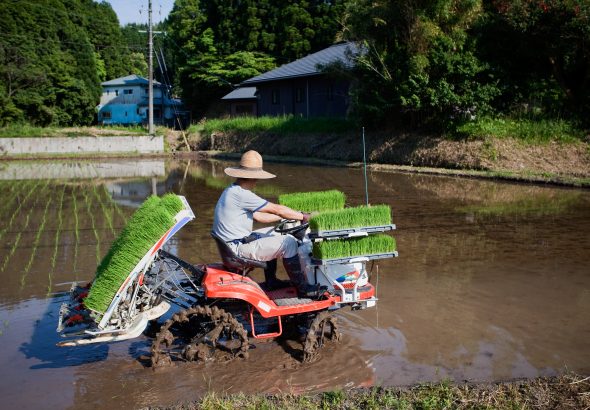
Have you ever considered traveling to Japan to do farm work? If you are interested in learning, enjoying, experiencing and having fun, this can be a perfect opportunity for you. For many Japanese people, good food quality is of great importance, as well as knowing the origin of the food. With a job on a farm, you will be learning about these aspects. Furthermore, you can have the experience of living with a family at a farm and thereby also learn about the Japanese culture. A job at a farm can be pre-arranged by World Unite!, and it is possible for you to choose if you prefer working on a big farm, or a smaller farm. These jobs do not require previous farm-work knowledge, but it does require a conversational level of the Japanese language. If you do not know a word of Japanese, or if you don't have the confidence to speak Japanese, there is still no need to worry! You will have the chance to join a language course before you start working. During this language course, you will get to know as much Japanese as you wish and have time for, and you can expect to improve your newly acquired language skills even further once you start interacting with the farm workers at your new workplace. So, what kind of work will you be doing? There are different options you can choose from, and your tasks can include: Working with horses, cows, or chickens. Your tasks can be feeding, cleaning, milking, cleaning the stables etc. Growing cut flowers and ornamental plants Seeding, growing and harvesting crops. These could include millet, corn or wheat Planting fruits and vegetables, harvesting, and processing For your work, the average salary ranges between 690-1500 Yen per hour. The farm work jobs are full-time jobs, where you can expect to work 5-6 days per week, with an average working day of 7-9 hours. How, and where will you live? You will be accommodated at the farm where you work, and your meals are offered here too. The costs of accommodation and meals will be deducted from your salary, but since those costs are low you will still have enough salary left to save some money every month. The kinds of accommodation and meal opportunities that you will have differ according to the farm you will be living at, but we will suggest farms according to your preferences: With a farmer family or at a farm staff accommodation In a single room or in a dorm room Your meals may be cooked and ready to eat, or you may get raw food items that you can cook for yourself Do You Want to Know More? Does this sound interesting, and would you like to know more? Then visit our webpage at http://www.world-unite.de/en/working-holiday/japan/farm-work-jobs-in-japan.html
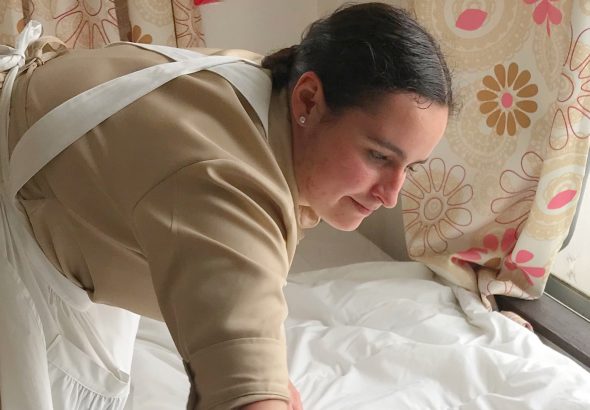
We have visited Katrin H. (20) at her workplace at a hotel in Ginza, Tokyo's posh area. Katrin is doing a Working Holiday in Japan and works at a housekeeping job – so if a bed has to be made with speed - Katrin is the one to come to the rescue! The hotel is very clean and welcoming, and you will meet a helpful and friendly staff. Katrin, what made you decide to travel to Japan to work? It is actually quite a long story because the first time I came in contact with the Japanese culture was all the way back in primary school through my friend. Ever since meeting her, I kept on really appreciating the Japanese culture. Then, after my high school graduation, I didn’t want to start university right away. So I just thought, okay, this would maybe be my last chance to come to Japan for more than just a vacation and experience the culture. So I went, and here I am! How did you find the job at the hotel in Ginza? I got it through the internet because the other job introductions that I got through “HelloWork” (employment agency) didn’t have any available jobs at that moment. So I searched online, and then I found another agency similar to “HelloWork”, only for hotels. I applied, and they immediately wrote me back that they had some hotels that were searching like crazy for people. I went there, got an interview, and then I heard I got the job the next day! For how long are you planning to work at the hotel? I started to work at the hotel in October 2017 and I will quit in May 2018, because I am planning to travel to Kyoto, Osaka and Nara. After that, it is time to go back to Germany. What does a typical workday look like for you? Every single day I go to work during the rush hour – like many other people! Except for Saturday and Sunday because that is my weekend. When I get to the hotel, I change into my uniform and then wait a little bit until everything is prepared by my boss. I then search for my name on the hotel whiteboard in order to see which floor I am going to be working at. After that, I take the paper with my name and the rooms on it, I get my keycard, and go to my floor and make the beds for 6 hours. After that I'm finished, and once my supervisor has approved my work, I change back to my own clothes and go back home. What kind of demands come with your job? You should speak a little bit of Japanese, because there are some guests who want to talk to you, for example, because they don’t know how to turn on the TV, or they ask you other questions. So a little bit of Japanese is really, really helpful. I don’t think there is anything else actually. Just to be able to work normally and to be physically healthy, and speak a little bit Japanese so you can interact with the guests and with the boss. How much do you earn, and is it enough to cover your living expenses? I think, if I work full-time like I would do in Germany, I think I would get 120.000 yen per month plus travel expenses which the hotel covers. I can live off that and still save money for later for my travel, so it is really good. Do you enjoy your job? It is really stressful sometimes, but it is great. It is really great, because you get to know different people. I don’t think we have any Japanese person working in our hotel, besides our boss, but you learn to interact with each other. The others at my job usually know some Japanese and their mother tongue, so it is just like, okay! I don’t know what you say! So you have to speak Japanese to understand your co-workers as well. Also, you really feel great after a guest comes to tell you that they had a good stay, then you feel that you have done a good job. It was really stressful, but it makes you smile. Are there certain aspects of your job that you do not like? Yes, I don’t think there is any job that only has positive aspects. But sometimes I feel like the hotel’s rules for cleanliness can be stressful. Everything has to be very perfectly cleaned, so at times, it feels like they are a bit too strict. Do you think that working at the hotel helps you in improving your Japanese? Yes, a lot. It has really helped because most of the guests are Japanese, and you need to interact with them. You can speak English, and some of the guests try to speak to you in English because they see that you are a foreigner and think that you cannot understand Japanese. But I can actually speak Japanese, so there are no worries there! And every time I say that I can speak Japanese, they feel relieved, because they can interact with me, and that is really great and really helpful for me as well. I learn many new words, and it helps me to use my grammar in the correct way. It is really helpful. I also learned how to make beds really fast! And how to clean toilets and bathrooms in general. I think it is really helpful, but maybe not that helpful in Germany. But it is a great experience and I like my co-workers, so it is great there. My co-workers can be divided into 2 groups: Chinese and Filipinas, and then I am the European in the middle. There are no others – just my boss who is Japanese. So we cannot communicate in English. My Chinese co-workers can’t really speak English and the Filipinas and my boss can speak English, but the only way for all of us to understand each other is to speak Japanese. When we have meetings, for example in order to improve our work, or to handle customer complains, then everything is in Japanese. And because some of the Filipinas cannot speak Japanese that well, the shift manager has to translate it into Tagalog, and then there is another co-worker who is Chinese/Japanese who translates into Chinese to the Chinese employers. So there is a lot of translation going on, and you can hear a few words here and there! For me, if I don’t understand something, then I can just ask my shift manager, and then she can tell me what the meeting was about once more in English. But all in all, I can just say that I think it is a really nice job!
Have you ever heard of a ryokan? A ryokan is a traditional Japanese hotel, and by doing a working holiday in Japan, you can get the opportunity to work in a ryokan where you will learn about traditional Japanese culture, culinary arts, service of the highest level, and much more. Ryokans are very high standard hotels, and they are visited by Japanese as well as foreign tourists. There are usually around 14 rooms in a ryokan, and the rooms are traditionally designed, with no furniture apart from a low table which is used to serve breakfast on. For sleeping, the guests get tatami mats, and the bathing facilities are often large shared bathing areas, fed by hot volcanic springs called onsen. A job at a ryokan can be pre-arranged by World Unite!, but in order to get a job, you need to have a conversational level of the Japanese language. If you do not know Japanese, you are much welcome to join a language course, where you can expect to gain the necessary language skills after attending classes for 1 month. So, what kind of work will you be doing? There are different work tasks, which will include: Housekeeping Preparation of futons Dishwashing and kitchen assistance Preparation of tables and serving food Cleaning the onsen area For this work, the average salary ranges between 690-1500 Yen per hour. The Ryokan jobs are full-time jobs, where you can expect to work 5-6 days per week, with an average of 7- 9 hours of work per day. How, and where will you live? Most often, the ryokans arrange your accommodation, and this can be different according to the ryokan you will work at. Your costs for accommodation and meals will be deducted from your salary, but since these costs are low you will still have enough salary left to save some money every month. Different accommodation options include: Single or dorm room in a staff housing facility near the ryokan Accommodation further away from the ryokan, transportation will be arranged Meals provided at the ryokan Do You Want to Know More? Does this sound interesting, and would you like to know more? Then visit our webpage at http://www.world-unite.de/en/working-holiday/japan/ryokan-jobs-traditional-restaurant-hotel.html
To many people, foreign tourists as well as Japanese locals, Hokkaido's image is one of low temperatures and snowy mountains. It's no wonder most people go to Japan's northernmost island for winter sports. However, this amazing place has so much more to discover than just skiing down a mountain! I already visited the landscape in summer of 2009, and this time I wanted to see it during winter as the weather during summertime is a bit similar to Germany. But unlike Germany, Hokkaido turns into a snowy wonderland during the winter. If you are in Japan for a working holiday, do yourself a favor and make sure to spend a week or so at Japan's prime winter sports destination! Sapporo This year I spent around one month in Hokkaido. I decided to set up my freelance headquarters in Sapporo because the capital city has the best connection to the public transportation. Another aspect is that most of my friends are living in or near Sapporo. During the first weeks I explored Sapporo and its vicinity. As Sapporo is not a sprawling city, you can reach many spots within an hour of walking, so I walked to the Okurayama Ski Jump Stadium when a Ski Jumping event was going on. I never saw this sport before, and it was so amazing to see the competitors flying! If there is no event going on you can watch a training if you are lucky. Next to the stadium, there is a winter sports museum. Unfortunately it turned out to be closed in January, but when I visited Sapporo in 2009 it was open and I recommend you stop by. The best part of the musuem is that you can practice different winter sports with simulators, it's almost like being on the slopes for real! Other interesting spots you shouldn't miss when you are in Sapporo were the Sapporo Clock Tower where you can explore the history of the city, the Susukino nightlife district, and Mount Moiwa. When I went up this mountain using two ropeways, I was stunned by one of the most beautiful views of the city and the ocean from the top. Penguins in Asahikawa In the begin of February I went to visit a friend in Asahikawa. Because I stayed with his family, I got the chance to see from up close how a Japanese family lives in Hokkaido. My friend and I visited popular spots in the city, like the science museum and the zoo. The zoo of Asahikawa is quite a famous place in Hokkaido. It is not big, but the highlights are the nice arranged habitats and the penguin walk, where a group of penguins walks through the public area as seen in the picture. The renowned Asahikawa Yuki Matsuri (Asahikawa Snow Festival) is also a must-see. You will see snow sculptures along the river, ice slides, and be able to try many delicious kinds of food. I also visited the judo club of my friend's sister and watched the class practice. At the gym we met the class teacher of my friend, and he invited me to come to the high school the next day. I was really excited to get the chance to see a Japanese high school from the inside! The students were really amazed to see me, a foreigner, in their school. During English class, I assisted the teacher by helping the students while they prepared a group speech. After class finished, the teacher guided me around the school. This experience was a unique moment I will remember for sure! During my stay, the Sapporo Yuki Matsuri (Sapporo Snow Festival) also happened to be in full swing. I even arrived in time to see how artists built up their ice sculptures. After the event kicked off, the city was full of gigantic snow walls with pictures and ice sculptures lit up in every color. For the last week of my stay I visited several places. First on the list was visited Obihiro. I am a horse lover, so my main reason for visiting this city was the horse racing stadium, which is unique in the world. Here you can see how one of the mightiest horse breeds in the world is running on a special racetrack. Bannei horses are not cantering through the track like they do during a normal race, but they are pulling a heavy sled over 2 hills. It was very special to me to be able to watch this spectacle. Hot Springs, Bears and Drift Ice The next city on my list was Noboribetsu, which is popular for its hot springs, old city with people in ninja costumes, and bear park. In the bear park, you can see brown bears doing funny tricks to get attention and food from visitors. When I took a short walk through the city something that stood out were the many statues of Oni (demons) along the way. There is a place near the city named Jigokudani, also known as 'hell valley', hence the statues. It is a spectacular place with hot steam vents, sulfurous streams and other volcanic activity. It is from this valley where most of the onsen in the vicinity get their hot spring water. At last I went to the eastern part of Hokkaido. My first stop was Kushiro, which is famous for its wild nature and Japanese cranes. In the evening I took the train to Abashiri and stayed here for one night because it would be an early wake-up call the next day for a boat trip to see the drift ice. On an icebreaker, we went for a one-hour tour through the bay and the drifting ice, which I already saw from the train one day before. We were also lucky to see Stellerˋs sea eagles next to the boat. It was a great end to a trip to remember! About the author Michaela has been interested in Japan since she was young, and aged 25 she decided to go on a Working Holiday to the country that has always felt like a second home to her. Feeling safer by going to Japan through an organization, having the back-up of World Unite! turned out to be a good investment. Michaela found some great jobs during her stay on a Working Holiday visa (one job was scuba diving assistant!), and she also took the opportunity to travel around many areas of Japan. In the end, Hokkaido turned out to be my favorite place, as here you can find a great mix of nature and city.
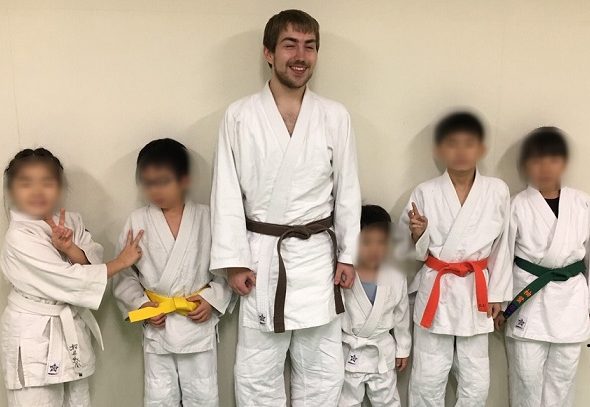
Alexander S. (19) from Germany tells us about his Working Holiday experience in a dojo in Tokyo. He has already a lot of experience as a judoka and has been working as a judo instructor in Germany. Now he got the terrific chance to work in the country where judo originated and learn the trade from actual Japanese instructors. He now works as one of the trainers of a kids' class. Alexander, how did you find this job? It's an interesting story. I was actually interviewing for a restaurant job, and it so happened that a few sport companies were also having a meeting in the restaurant at the same time. Since I wrote on my CV that I have practiced judo for many years, I was invited by one of the organizers to join the meeting and I got offered this job afterwards. I was indeed very lucky. When do you work? I work at the dojo twice a week, usually Wednesdays and Fridays. The kids' training program is from 4.30pm to 6pm, and then I join the adult training hours. Sometimes one of the children receives a private training, during which I assist as a second trainer. What do you find challenging about this job? My Japanese level is very low. All my knowledge comes from a 2-week crash course I took in Germany. I am lucky that the other trainers speak a bit of English, and I even teach in English on Fridays. The school offers this special program where we try to teach the children some English while they train, so they gain more than just the physical abilities. I actually already knew quite a few judo terms in Japanese as I learned them while I was training in Germany. If there is something I can't explain using language, I just show them what I mean. So it turns out the skill that is actually most important for this job is my judo ability, and not my (Japanese) language ability. Does this job help you improve your Japanese? Yes, absolutely. I even come a little early to talk to the children sometimes. Sometimes I also study Japanese between trainings. I just bring my study books to the dojo and if I have questions there is always someone to help and advice me. What did you learn doing this job? Besides my Japanese, my English has improved as well. I have to communicate a lot in both languages so I slowly get better. Other than this I learned a lot in the adults training and improved my judo skills. This will be very useful for when I go back to work as a judo instructor in Germany again. Do you enjoy the job and are there things you don’t like? To be honest, there is nothing I don't like about this job. I like every aspect about it. It combines well with my other job at the former mentioned restaurant. It helps me balancing my weekly schedule and I stay physically fit. We have a lot of fun during the training and I gain experience. It's just the perfect combination of jobs. How much do you earn? Is it enough to cover your living expenses? I earn 1000 yen per hour and work only 2 days a week. This is fine, but of course not enough to cover my expenses. I really need the other job in the restaurant where I work 8 hours a day, 3 days a week. With these 2 jobs together I make enough to live in Tokyo and I still have enough time for private activities and trips. What brought you to Japan in the first place? I'm sure my answer will not be a surprise to many, but I have to admit it has to do with anime. Watching anime and reading manga made me curious about Japan and now I can experience the culture first hand. Would you recommend Japan for a Working Holiday? Yes, I would recommend it. Most people choose Australia and New Zealand for a Working Holiday, but I think Japan is still special and relatively unknown. There's a whole new culture to explore and I have learned so many interesting things already. It's absolutely great to spend some time in Japan in this way, working here gives me a new perspective. The language barrier might be higher than in other countries, but it wasn't as hard as I first expected. A lot of people in Tokyo can actually speak some English, and even if they don't, many people try hard to help you using just gestures and the few English words they know. " order_by="sortorder" order_direction="ASC" returns="included" maximum_entity_count="500"]
We visited Marcel S. (19) at the Butler Café in Tokyo where he has been working for a few weeks now. We had a great time and enjoyed being entertained by three charming butlers! It wasn't just the service that made it worth going, we were also surprised by the delicious dishes they served us. Afterwards we interviewed our Working Holiday butler from Germany about his experience working for the Butler Café. Marcel, how did you find this job? I found it on the internet. Someone of my share house mates told me that there is a great website for foreigners to find jobs like this in Japan. This job was actually the first one I applied for, and it worked out well. Since when have you been working at the Butler Café and what are your general working hours? I've been working here for almost 4 weeks now and I hope I can stay here for a few more months. The working hours depend on the day, for weekdays I'd say the average working time is about 3,5 hours per shift, but in the weekend I'm working up to 7 or 8 hours. We arrange the work schedule according to the number of reservations we receive online. What requirements came with the job? Obviously you have to be kind if good-looking in the employers eyes. The first thing they check when you apply is your photo, then they want to know whether your English conversation skills are strong enough. Since you only speak English during the job, it is mandatory to speak an advanced level of English. Another condition I heard of is 'looking foreign', as they prefer western butlers in order to create a 'European butler atmosphere'. So most of the employees are from Europe. It's also an advantage to be a good actor as the way you're expected to behave as a butler is quite different from what you would normally behave like. And then probably the most important requirement is that you should actually enjoy doing this job. You should not just do this job for the money. How much do you earn? Is it enough to cover your living expenses? I earned 1,000 Yen per hour until now, because that is what everyone gets in the first month. After you complete your training you can earn up to 1,500 Yen per hour, depending on your skills and popularity with the customers. What are your duties at the Butler Café? My first and most important duty is to entertain the princesses, this is how we call our customers. If they feel good and enjoy the time they spend here, we are doing a good job. I have to serve food and tea, have a little chat with them and if they want to we offer the extra service of taking a picture together. I adopted a stage name by the way, my butler name is Alfred because that is seen as one of the typical European butler's names. Do you enjoy this job? Are there things you don’t you like about it? Of course I'm enjoying this job. I have always been into acting and now I get even paid for it. I feel very lucky that I can actually do something for a living in Japan that I also enjoy. The only unfortunate thing about this job is that I can never get in touch with the customers after they leave our café. This is a strict rule, as it helps keeping the fantasy alive. Do you think working for the Butler Café improves your Japanese? What else did you learn? We communicate in English with the customers as well as with the owner, so if someone want to improve their Japanese this might be the wrong job. My Japanese level hasn't really improved since starting work here. What has improved are my intercultural communication skills. Trying to understand people who barely speak your language is hard in the beginning. I have been able to communicate using English, gestures and a little bit of Japanese, and it has surprised me how much I am actually able to get across without having a language in common. What brought you to Japan in the first place? Japan is a country with a unique culture that has always fascinated me. Besides Japanese culture being very different from German culture, I actually see things we have in common as well when it comes to the way we think. The cultural aspect was actually the main reason I decided to go to Japan. I wanted to visit hot springs, eat sushi and learn the language using it in real life. Japan is a country that has so much to offer that I would gladly stay here longer. If there wasn't any language barrier I could imagine living here for several years. Would you recommend a Working Holiday in Japan? Very much so, Japan is a country where everyone should have been at least once in their life. I would recommend coming here either for a Working Holiday or just to travel. The people are friendly, it's extremely safe because of the low crime rate, and with a little bit of luck you can find a job you like! " order_by="sortorder" order_direction="ASC" returns="included" maximum_entity_count="500"]
Sebastian H. (20), who graduated high school in Germany 1 year ago, tells us about his Working Holiday experience in Tokyo. He was working as a waiter in an Italian restaurant for 5 months together with Japanese locals and other foreigners from all over the world. Sebastian, how did you find this job? I found this job on the internet after looking for many kinds of different jobs here. I contacted many people and places, I also got many replies but in the end this job fit me the best. Because I had previous experience as a waiter it wasn't too difficult to get used to the job, even though Japanese customer service is quite different from what I was used to at home. What were your general working hours and what kind of customers visited the restaurant? I worked at the restaurant 4 or 5 days a week. My working hours were between noon and 3.30pm; then I had two hours of free time, and after that I continued working from 5.30pm to midnight. Most of the customers were middle class, there were many salarymen or families with children. I think they came to enjoy good Italian food. Sometimes we also served tourists, and one time we even had a celebrity customer: the creator of the game 'Final Fantasy'. Some of my co-workers were quite star-struck! What was demanding about the job? It was a big advantage that I already had a lot of experience as a waiter in Berlin and Australia. I didn't really need to speak Japanese to understand what to do. I just had to learn a bit of Japanese, as some of the customers didn't speak English, however, our usual customers don't expect us to speak the language fluently. They would come here for an Italian atmosphere, which is why we greet them with the words "Buon giorno", and then ask for their orders in English or Japanese, depending on their level of English. How much did you earn? Was it enough to cover your living expenses? Yes, my salary was definitely enough to cover my living expenses. This was one reason why I wanted this job in the first place. I earned 1,100 JPY an hour here, had my transportation paid, and I could eat two staff meals for free every day. This made it possible to have enough money to enjoy my life in Tokyo. However, it was exhausting at times to work five long days a week. What were your duties at the restaurant? My duties at the restaurant were the regular duties of a waiter like taking customers' orders, serving them, sometimes washing dishes, setting the tables and so on. Sometimes we had people celebrate their wedding at our restaurant, then I assisted and served the wedding guests during the party. Did you enjoy the job? And were there things you didn't like? What I really enjoyed about this job was the wonderful cozy atmosphere at the restaurant, which reminded me of my time in Berlin. It actually didn't feel very Japanese; it was more like a multicultural place with English as everybody's common language making it easy to work here. We were not just doing our job, we were all friends at the restaurant. We spent a lot of time together so it's important to have fun while working with each other. Of course it doesn't mean that I didn't take the job serious. What I didn't like so much about this job was that I had to wear a 'mask' all the time. It was not possible to be myself, I always needed to represent the restaurant, smile and be friendly, even on days when I didn't feel good. The one thing I am thankful for is how my co-workers tried to cheer me up and motivate me to do a good job on those days. One other thing I didn't really like is that newbies have to wash a lot more dishes than the other staff. That was very exhausting in the beginning. Do you think working for the restaurant helped you improve your Japanese? Absolutely! There were some Japanese co-workers I could talk to in Japanese if there was time. After I became more confident I also tried speaking to customers in Japanese. The other waitstaff helped me a lot when I had questions about specific vocabulary, so I had a good chance to improve there. They were really helpful. Besides the language, what else did you learn doing this job? I learned a lot about myself. An important thing that I learned is that I really never want to work as a waiter for a prolonged time in the future. This is not the right job for me. It's exhausting and I also don't think it would fit my personality. My actual goal is to study medicine in Germany or Austria, and this experience made me even more motivated to do well in my future studies. I have also developed a strong sense of responsibility because for this job we all had to rely on one another. One time I was sick on a really busy day and could not go to work, so the others had to cover for me. I felt deeply sorry and responsible that time. What brought you to Japan in the first place? After I finished high school in Germany and got my Abitur (high school diploma), I wanted to go abroad for a year. My original plan was to travel to either Australia, New Zealand or Canada, but my friend convinced me to visit Japan as well. He told me some fascinating things about this country, so I became interested in the Japanese culture beyond anime and manga. We started our journey together in Australia where we did a working holiday for around 3 months. Afterwards we went to Japan together, where we planned to stay a whole year. As my friend wanted to stay in Tokyo while I was eager to travel around we went our separate ways. I spent the first 5 months in Japan traveling from Tokyo to Naso in Tochigi, then back to Tokyo and I headed west to Hiroshima and Osaka. Finally I reached Kyushu, where I traveled through cities and villages and saw a lot of a less famous parts of Japan. I managed to travel on the cheap by hitchhiking and couch surfing. I had a sleeping bag with me and a few times some nice Japanese people even offered me a meal. I always felt safe in Japan. There is not much crime and the people are helpful, which are the best conditions for backpackers. Today is actually my last day at work here, from tomorrow I will take 2 weeks to enjoy Tokyo, then I will travel through to Ise to learn about the pearl divers and when I leave Japan after that I'm going to have a holiday in Thailand. I'm going to make the most of my last few weeks here in the East! Would you recommend Japan for a working holiday? I would absolutely recommend doing a working holiday in Japan to other people. I do think however that you need at least a basic interest in Japanese culture to be able to adjust well. My suggestion would be to not stick to only Tokyo or other big cities, but to also travel to smaller places and getting to know the people there. It can be a wonderful experience for anyone. Japanese people are extremely polite, much more than in Germany I feel. I gained a lot just by talking to them. I think traveling in Europe would have been much harder and the people might not have been as helpful as here in Japan. Is there something you will always remember when you think back about your time here? Every day was a little bit special in itself, and it was the people who made the job the way it was. What I enjoyed a lot was when the work was finished, and we could just sit there and talk about our private lives like friends do. I made some real friends here, and will definitely stay in touch with them after I leave Japan. " order_by="sortorder" order_direction="ASC" returns="included" maximum_entity_count="500"]
Ramen is one of Japan's most popular dishes. Many salary men have a bowl of ramen after work in one of Tokyo’s many ramen joints. It's quick, cheap and tasty! So when you are on a Working Holiday in Japan, working in a ramen shop is a great way to really dive into the Japanese experience. We spoke with Ahmed I. (20, from Hamburg in Germany) about his job at a ramen restaurant. Ahmed, could you tell us what a typical work day at a ramen restaurant is like? My work starts in the morning at 9.00am, and because it takes over half an hour to get there by metro I have to wake up quite early. Every morning I start with cleaning. After that I prepare everything in the kitchen before the first guests come, like refilling the green tea cans, putting them on the counter and setting the tables. When the guests come to the restaurant I welcome them with the words "irasshaimase"(be welcome). I then take their orders and serve them their dishes with the words “omatase shimashita" (sorry that you had to wait). It is especially important to speak in a very polite way to the customers. What is demanding about the job? The whole staff consists of only Japanese co-workers, so the communication is not always easy for me. Another thing I had some difficulties with was "to speak loudly”. Every time I got in contact with our customers, I was anxious to speak with a clear and strong voice. This was a very big problem for me in the beginning. Coming out of your shell is not always easy. Which language requirements come with the job? It is very important that you can speak basic Japanese and of course some English as well. All the people who are working here are Japanese, so this is why it is essential to speak at least a little bit of their language so you can communicate. Of course, you must be willing to improve your language skills fast and try to understand things quickly. Do you enjoy working at the ramen restaurant and is there something you don't like about it? I have to say that it is a really nice job. The other staff members are very friendly and I get a small bowl of ramen for free at lunchtime every day, which I enjoy a lot. On the other hand it is sometimes a bit difficult to communicate with people because they speak Japanese fast, which is still hard for me to understand. Another negative aspect would be the short breaks. They sort of expect you to continue to work after only around a 10-minute break. How much money are you earning and is it enough to cover your living expenses? I earn 1,000 Yen per hour, which is around €8. I had to adjust my lifestyle (I'm living in a share house) and save some money in order to let that be enough to live in Tokyo. I'm working here for 4 months now and got used to it. How did you find this job? I talked to a friend at the share house who was already working there and he strongly recommended me to apply. He was quite satisfied with the job, so I thought it would be a good idea for me as well. Did you make any special memories which you will never forget? Yes, I had a great moment when my boss came to me one day and told me that I could design the menu. I really love digital photography, so it was a very gratifying task to take pictures of all the dishes and create the menu. Do you think working at the ramen restaurant improved your Japanese? Well, of course it improved my Japanese because I had to learn new words to speak properly to the customers and communicate with my co-workers. But I have to say that I could not improve as much as I would have liked to because people are very busy at their workplace and didn't have time to explain everything. This can't be helped and I hope I will keep on improving. What are you doing besides working? I like non-touristy places very much. Often I would visit some nice spots in Tokyo, meet friends and go with them on hiking tours and day trips. I also like the bars in Japan, which I sometimes visit on the weekend. Why did you choose Japan? I have always felt a deep connection with Japan. The pop culture, traditional culture and the everyday life caught my interest so I decided to go there and experience it for myself. Would you recommend doing a Working Holiday in Japan to others? Oh yes! People should go out and do something exciting with their life. Traveling to different countries, meeting new people and discovering new places are all amazing opportunities to gain new experiences! Japan is beautiful and I would strongly recommend people to go there. " order_by="sortorder" order_direction="ASC" returns="included" maximum_entity_count="500"]
Enoshima, a small island in Kanagawa Prefecture, is a popular resort and sightseeing place. A bridge connects the island with the shore area making it easy for visitors to walk there and enjoy the beautiful coast view. The Road to the Sea Candle Garden When you arrive at the island, you will see many tourist souvenir shops in a narrow street sloping slightly upwards to a post office. It has the special charm of a traditional rural town and a beautiful Shinto gate (torii) at the end of the street. When you walk towards the gate you will pass many small restaurants and street food stands with mostly seafood offerings. On hot days you can indulge in one of the many ice cream shops there. Climbing up the stairs you will find some Shinto shrines where you can pray and buy charms for various purposes, such as luck, health, love and traffic safety. Enoshima is also a very popular place for Japanese visitors. You will see many Japanese families with their small children and couples on a romantic trip. After enjoying the serene atmosphere at the temples you will reach the main attraction of Enoshima Island, the Sea Candle and the Sea Candle Garden. The tropical garden has many small walkways decorated with hundreds of colorful glasses with candles inside. There is a romantic and fascinating atmosphere when you go there by night, but also during the day it's a wonderful place to visit. For a nice view of the harbor area, look for the cafés where you can admire the view while enjoying some good food or drinks. Sea Life During the summer season the beach area around Enoshima is full of people who love water sports such as surfing, swimming or sailing. Another popular activity in this area is fishing. If the weather outside isn't comfortable you can visit the Enoshima Aquarium, which features a great collection of marine animals and even has a dolphin show. Enoshima makes for a great day trip, and not least because of its famously fresh seafood. When the weather is crisp and clear it's even possible to have a great view of Mount Fuji. If you come from Tokyo by train you will most likely visit Kamakura first on the way down to Enoshima. If you're visiting both places buying the Kamakura-Enoshima Pass for 700 yen in Tokyo is a good option. You can also go to Kamakura by local trains and buy a 1-day pass for the Enoshima Electric Railway (Enoden) for 600 yen. This pass allows you to stop at popular temples in Kamakura as well as in Enoshima.
We’ve met Michaela Z. (26), a German currently living in Shinjuku, Tokyo. She is in Japan for a Working Holiday and a little more than half a year ago she had the opportunity to job for a scuba diving school in a city in eastern Shizuoka prefecture. Michaela was working as the diving teacher's assistant for almost two months before coming back to Tokyo. She told us about her time in Shizuoka. Michaela, how did you land this job? I have been planning for quite a long time to travel to Japan. As I wanted to really immerse myself in the Japanese culture, I decided to come for a long Working Holiday, because working naturally gives you a deeper insight into a foreign culture than, for instance, a short trip. Due to the fact that I wanted to start my adventure on a short notice, I felt safer being supported and therefore decided to use the service of World Unite!. They also helped me to find the job in the scuba diving school in Shizuoka. I simply informed them about my wishes: with a university degree in Hotel and Tourism Management I wanted to find a job related to this area, prior to my departure to Japan. I was introduced to the scuba diving school and got hired for the summer. From when to when have you been working for the diving school? And what were your general working hours? I came to Japan in summer 2016 and after a few days of living in a share house in Tokyo and getting used to the new thermal environment I took the train to Shizuoka to start my work. My new Japanese boss, the diving school's owner and teacher, welcomed me warmly. Originally I was asked to work there for one month, but as I liked the job and my boss was pleased with how I was supporting him and felt that I was a reliable worker, I could stay a few more weeks. After that I went back to Tokyo. There were no fixed daily working hours. But usually the working day started at around 7 am and ended at around 3 pm. Before, during and after the diving lessons the customers had to be taken care of. As long as that was assured, everything was fine. Once a week I could take a day off. But also on working days I had quite an amount of free time, too. When my boss had time, he took me on short trips into the hinterland of Shizuokas. One time a neighbor, the owner of a hotel, took me with him for a hike in the Japanese alps. What kind of demands came with the job? Special skills or previous knowledge about diving or anything weren't required. I was taught everything I needed to know within the first few days of working. During these days I have been assistant and student at the same time. I even made my diver's licence after three days. Although, I also have to admit that it was a plus to already have made experiences in the hotel and restaurant business back in my days as a student. My boss didn't need to explain everything to me twice, as I kind of knew what needed to be done. Not only during the diving courses, but also when it came to care for the customers who stayed at the school owner's guest house. The house is located right next to the ocean. It was such an amazing view! How much did you earn? Was it enough to cover your living expenses? Instead of a salary I received free accommodation at my boss's house and free catering during my whole stay. Also entry fees for several locations such as museums and hot springs were covered. But I had to pay for my first diver's licence. Therefore I had to come to Japan with a little bit of savings. Luckily I could do my second diver's licence for free, though. In late summer, when the diving season came to an end slowly but surely and the diving school became less busy, I started to help out at the neighbor's Hotel for a few days. I received 10,000 JPY a day for that. What were your duties at the diving school? I was basically assisting the owner of the school with his daily work. For instance I needed to prepare the equipment for the diving lessons, explain essential rules to the students and look out for them during the diving. My boss isn't only running the school, but is also lending his boat to his customers for day trips including BBQ and water sports. My task was to welcome the customers and accompany them during their boat trip. While the diving teacher has been snorkeling with some of his students, I needed to watch out for the safety of the on the boat remaining customers. Besides the main business of diving lessons and boat trips, the school's teacher is also running a guest house. My tasks were to prepare the breakfast, do the laundry, clean the house or make the beds. As it was a traditional Japanese house with wooden floors, a lot of windows and tatami mat floors in the guest rooms, the maintenance asked for a careful treatment. Sometimes I did some gardening, too. Did you enjoy the job? And what didn't you like about it? I was enjoying my time in Shizuoka to the fullest. Supporting my boss with his work was a lot of fun and I loved the location. The only disadvantage I saw was that I didn't have a driver's license or a car. In the area the school is located, you really need a car to get somewhere. But well, I had a bicycle, so I often used it for rides along the promenade. Day or night, I could always use my free time to relax at the sea side behind the house. Doing so I had the rare chance to see the blue marine phosphorescence at night. Do you think Working for the diving school helped you improving your Japanese? My boss spoke English fluently, therefore it wasn't difficult to communicate with him. When we both had spare time he taught me some Japanese. During the breakfast with the guests he even asked them to practice their English on me. And the other way around, I was asked to try to speak in Japanese to them. Most of the guests were girls of my age, so we spent our free time together, too. They enjoyed teaching me new words. That helped me to improve my Japanese a little bit. We used to speak in a mix of Japanese and English. In addition, my boss's girlfriend, a Japanese language teacher, visited us quite often on the weekends. She used to live in Austria some years ago and knows some German, so she helped me understanding Japanese grammar and words. Besides the language aspect, what did you learn doing the job? I was working and learning at the same time, because I had never used any kind of diving gear before. I had the chance to complete two diver's licences and also a first aid course. Preparing the breakfast, sometimes alone, sometimes together with he guests, I learned a lot of traditional Japanese recipes, which I'm planning to use even after going back to Germany in a few months. Besides that I had the opportunity to attend Japanese traditional tea ceremonies several times, as my boss is a trained tea ceremony master. I got to know a lot about not only the famous Japanese green tea, but also about Moroccan tea making we even presented the country Morocco on a tea festival in Hakone, where we were handing out mint tea to the visitors in traditional clothing. As I was in charge of arranging our booth, I could live out my passion for decorating. What brought you to Japan to in the first place? What are you doing now back in Tokyo? I've been interested in Japan's culture and tradition since I've been a teenager. I guess most people start being fascinated by Japan in the first place through anime and manga, Japanese cartoons and comics, but for me it has been Japanese rock, pop and also traditional music that is captivating me since then. Listening to all kinds of Japanese music also made me fall in love with the Japanese language. I'm hoping to improve my language skills by doing this Working Holiday. I've actually been in Japan before once in 2009 for a short term cultural exchange program. During this time and also during the time in Germany when I was studying Japanese on my own, I got to know some Japanese people who became close friends of mine. Therefore I'm also using this Working Holiday as an opportunity to meet those people again. Right now I am living here in Shinjuku, Tokyo. While working as a part-timer, I'm trying to meet new people and old friends, as well as attending concerts of musicians that I most likely can never see live back in Germany. On the weekends I usually make short trips to cities nearby. " order_by="sortorder" order_direction="ASC" returns="included" maximum_entity_count="500"]
Comic Market or Comiket as I will call it from here on out, to the west usually is merely a mystical event. A place you've heard stories about, seen referenced in Anime and Manga, seen pictures of and fanart from. It's something that the majority of people in the western world have relatively little chance of experiencing, after all, it is on the other side of the world and there really is no comparable event anywhere in the world. During my one-year stay in Japan, I had the chance to visit Winter-Comiket and it made it for an absolutely fascinating experience I'm unlikely to forget all too soon. For starters, let me explain what Comiket in itself is about for those who aren't familiar with it. As aforementioned, the name "Comiket" stands for "Comic Market". It's a bi-annual event focusing on what the west generally dubs "Otaku-culture". This includes pretty much anything from Anime and Manga, Doujinshi, over music up to things like fanfiction or self-published web novels. The possibilities are near endless. " order_by="sortorder" order_direction="ASC" returns="included" maximum_entity_count="500"] The difference to your average foreign con is the actual focus of the event. Although a huge amount of companies are represented at Comiket and depending on their popularity can attract absolutely massive crowds, the event itself is mainly about fan created content. This manifests itself in several gigantic halls, packed to the brim with booths of different artists trying to sell their work over the course of the day that rotates each day in order for as many people as possible to be able to put their work on display. Being generally handled as the biggest convention in the world, it should be no surprise that Comiket is not friendly to those who dislike large crowds. The 91st iteration, the one I visited recently, listed over 550.000 visitors over the 3 days in its after report, more than any other convention in the world. A crowd this insane of course also brings with it quite a few negatives. It's incredibly hard to get your hands on a lot of the popular doujinshi and company merchandise due to the sheer amount of people streaming into the halls, making it absolutely necessary to get into Tokyo Big Sight as early as possible. These circumstances have sparked people to start lining up at absolutely impossible hours to get their hands on the things they want the most. So guess what I did. On the first day of Comiket, I woke up at 3 am (Seeing as the Shiohama Sharehouse is relatively close to Tokyo Big Sight, this would mean that if I walked I'd arrive before the first train and with that a big majority of the people attending Comiket). There was a particular, relatively popular company selling a lot of things I wanted to get my hands on, so I did the thing a lot of Comiket attendees will do for their favorite merchandise and woke up around the time I would usually go to bed. Packed with entertainment to pass the time, Food to feast on once I'd eventually get hungry and a good amount of caffeine to keep me awake throughout the day I made my way to Tokyo Big Sight, trying to mentally prepare for the more than five-hour wait I had ahead of me. I'm sure this must sound like absolute hell to most people and that was absolutely what I was thinking it would the evening beforehand, but as it turned out the waiting time was much better than expected. This was partially thanks to my luck of finding someone I would end up being friends with shortly after arriving but also thanks to the general organization of the lines. Although incredibly full from the start the lines don't feel nearly as cramped as one would think, you can leave the line at any point in order to get food or drinks at nearby vending machines and stands and even bring your own blanket or chair to sit on as you wait. In the end, the hour-long wait outside of Tokyo Big Sight in the morning may not be comfortable, but it's certainly not something that will make the entire con experience any less worth it. To me in fact, it only made it all the more memorable. The incredibly long waiting time only ended up building up my anticipation for the event even more and made getting to the booths I wanted to get to and buying the things I was planning to get all the more satisfying. If I were to go to Comiket again I would undoubtedly do it the same way again. Of course, if you don't have any specific, popular things you want to buy there's little reason to go through anything like this. Comiket's organization is absolutely impeccable and makes for one of the smoothest line experiences I've ever had. Of course, it helps that the convention in itself is 100% free meaning no ticket-checking is required, but around an hour after the convention opens there's already close to no need to wait in line anymore. Sadly, that means with all of the people that were originally waiting outside inside already the halls are absolutely cramped and, even worse, the lines for popular artists can be endless. Lines often have to be either led to the outside to continue lining there or have to be cut into several smaller parts so people can continue walking through the already relatively small corridors in between booths. 50 years of experience in holding Comiket, however, make all of this a surprisingly smooth ride as both the people working on site, as well as a lot of the visitors already know the general drill. The event feels chaotic, but it still at all times seems to be under people's control. It's an overwhelmingly odd experience, but for something as gigantic as this to work at least just as well as every smaller foreign con is fascinating to me. So would I actually recommend you to go to Comiket? Absolutely. Even if you aren't hugely into Anime and Manga, I do believe that at the very least the experience of the event is something that'll stay with you for quite a while. I do urge you, however, to think beforehand about how you would like to enjoy the event. Having done both the Hunting after things I wanted to have and the casual strolling around the artist's alley to find things to spend my leftover money on, I can say that both of them are incredibly fun in very different ways, but the former does have a lot of effort put into it beforehand. Doing research via the guidebook available in Akihabara the weeks beforehand, looking up your favorite artists, planning out the best routes for buying your stuff, getting up extremely early etc, is quite exhausting but extremely worth it. On the other hand simply strolling around the convention does, of course, have its own merits. The experience can be extremely calming and is a lot easier especially in its preparation. Instead of the constant running around it allows for a lot more actual looking through things and surprise artists you might not have found otherwise. Regardless of what you chose to do, Comiket is an absolutely insane experience and if you ever get the chance, I highly recommend you go through it!
Have you ever thought “Why is the Munich Oktoberfest called “Oktoberfest” when it actually starts mid September?”. Well, then you have obviously never visited one in Japan, because you would be even more surprised by the fact that many of the uncountable Oktoberfests here are not even close to the 10th month. They are being held throughout the whole year. One exception is the one in Yokohama, Japan’s second largest city, which is celebrating the festival since October 2002 and is famous for its authenticity. Here we had the chance to interview Alex S. (24), who was working as a promoter for two German beer brands. Alex, working at an Oktoberfest in Japan might sound fun, but is it actually? Yes, it really is! I’m having a blast. But you have to be a certain type of person to be able to enjoy it. I love talking, approaching people who I’ve never met before and start a conversation with them. If you can’t do that, you won’t have pleasure doing this kind of job. You know, my team’s main task is to hand out flyers to the Oktoberfest’s visitors and call out stuff like “Welcome to the Yokohama Oktoberfest! Please try our delicious beer!” to promote our beer booth, which sells Spaten and Hofbräu. We have to advise visitors about where to go, be in a good mood and jolly everyone along. You just have to be an open person and have the right attitude to do that properly. It’s also fun to dress up everyday. Our male staff is actually wearing the typical Oktoberfest lederhosen with a hat and the female staff is wearing the dirndl dress to create a German atmosphere. Spending the day with my Japanese and German colleagues is just a great way to earn some money. Would you let us know how much money you are making during this festival? Well, at the beginning we were told we'd get 1,000 JPY an hour, but after we were hired, the coordinator raised the hourly wage to 1,800 JPY which is of course fantastic. Especially if you are planning to do some traveling after the work is done, like I am. The festival lasts for three weeks. I’m working 6 days a week, 5 hours on weekdays and 7 hours on the weekend. So, you can see that I’ll receive quite an amount at the end of the festival. Have you done other jobs during your Working Holiday, too? Various! I came to Japan in January and didn’t work for a while, as I had saved some money back in Germany. As a rather sociable person I wanted to discover Tokyo and Japan first, before starting work. Therefore I lived very economically to be able to live here without having to work for a while. I even made a 4-week road trip with two German share mates which didn’t cost us that much. At the beginning of March we came back to Tokyo and I started my first job at a kindergarten, which I landed through Hello Work (a job agency). During the job interview the director of the institution was very skeptical because I don’t have any pedagogical qualifications, but I still received the job in the end. Once a week for one hour I was playing the role of the “English entertainer” for the Japanese children. I had to teach them something in a playful way. I chose the topics myself so I had to be creative, which was not as easy as it sounds. Another job I’ve been doing was coordinating a group of Japanese elderly people with an interest in Germany and German language. I’ve been handed over this group by a Japanese acquaintance that unfortunately couldn’t do the job anymore. Leading the group was very amusing and entertaining. In addition to that I was also teaching English as a private teacher. For example, there was this 12-year old Japanese boy from a rather wealthy family I’ve visited at their home. They even have an elevator in their single family detached house! Anyway, I didn’t really like that job because the boy has just become a teenager and he wasn’t really into doing his homework. In general, he was just super unmotivated and I never really knew to which extend I could scold him about that without the parents reacting negatively. I mainly did private teaching jobs for German or English learners. Whether you are going to like these jobs or not always depends on the outcome you will get. For example, if you can leave a good impression on a student’s parents, or the student actually improves hisor her language skills due to your lessons, it can be a pleasant job. But I also have heard from some share mates that they made bad experiences in this area. Maybe they didn’t have an open attitude towards their younger students. How did you land the job at the Oktoberfest in the first place? Again, thanks to a Japanese acquaintance. I met her first at an event of the Japanisch-Deutsche Gesellschaft [Japanese German Society] and we became friends and kept in touch. She then introduced me to a Japanese man called Shota via email. He was in charge of the booths for the Yokohama Oktoberfest and searched for promoters. Shota is a tall guy, over two meters, married to a German woman, used to professionally play soccer in Germany and is now working for a beer importer. After meeting him once he wanted to hire me and also some more Germans, so I asked my share mates. Only few were interested, which I find kind of strange. After all, the salary is not bad and the job description sounded pretty great. Maybe they weren't sure, if the job suited them? Anyway, the ones who were interested, I think around seven people, met the boss of Shota’s company once for an interview and were hired. That was in July, I think. What kind of demands came with the job? You have to be at least 20 years old and also have a valid working license. It’s also a plus to speak and understand English, as we are having a lot of foreign visitors. Oh and of course you should be German-speaking! Except from this, I dare to say that almost everyone could do this job. Even without speaking a lot of Japanese. You just need to memorise some lines in order to approach the visitors and advertise the beer brand. But I’m also realising that, as I said before, you need to be a bright person. Otherwise the memorised phrases come out monotonously. Some of my colleagues don’t seem to be really into the job, judging by their cold attitude from time to time. Do you think working at the Yokohama Oktoberfest helped you improving your Japanese? To be honest, I came to Japan with zero Japanese skills. I was thinking, hey, I can speak English, so why invest much effort into learning Japanese? But in reality it was harder than I thought not understanding the language. So after my road trip I studied very intensely. I wanted to be able to make friends and communicate with them in Japanese. And well, also with the ladies… I’m happy I’ve done that, because I could not only make some good friends, but it also led me to my girlfriend. The job at the Oktoberfest helped me a lot actually. I learned words that you rather wouldn’t learn in the first phase of your studies, such as "import" and "export". I kind of forced myself to memorise new words and phrases to be capable of doing my job properly. Talking to the visitors and my Japanese colleagues was fun and helped me to improve my language skills at the same time. Please give us a resume about your impressions about the jobs you were doing during your Working Holiday. I have to admit that that being a private language teacher won’t help you to get to know the real Japanese working environment. And you don’t even need to have any pedagogical qualifications to land jobs in the educational field in Japan. I would venture to say that you just have to act naturally and in a charismatic manner to succeed here. The same applies for the Oktoberfest. You are chosen to do this job for being the gaijin [foreigner], not for having a special qualification. But still I have to say that this job delivers more insights into the Japanese working environment than the job as private teacher. In addition to that it’s a good opportunity to make friends, because being the gaijin makes you kind of special and interesting to the Japanese. You are the one who has to approach the shy Japanese, although the fact that there are coming a lot of young and tipsy people makes this task a lot easier. After Alex S. finished his Working Holiday he went back to Germany and is currently searching for a dual course of study, which combines earning money with a traineeship and at best involves the topic Japan. After meeting his girlfriend he stopped studying Japanese, which he is regretting at the moment. He says that they are still together and he wants to start learning her mother language again. One of the nicest experiences Alex had while working at the Yokohama Oktoberfest has been the last evening at work, when he and his colleagues went out to have one last drink together.
Isabel (19) from Germany: "What I find so great about karaoke is that you don't have to be a great singer to have fun with it. You always go with friends as a group and it is particularly fun if you cannot sing, because everyone will join singing and bawling out, especially in case of songs everyone knows such as famous anime openings. It's always super fun. My favourite songs are the songs of Nishino Kana. The Karaoke shops always have some of her songs. Sometimes they also have some Western songs that you can sing in English. I also enjoy to sing Anime openings. There are plenty of Karaoke shops all over Tokyo. Just around the corner of our share house in Kiba there is a Karaoke place. In Shinjuku and Shibuya you find at least one Karaoke shop at every corner. Many of them belong to a chain of Karaoke shops. Choosing them you'll be on the safe side to have a fun time. However, there might also be cheaper non-chained places that are also good. Often you will find karaoke + a drink, or "All you can drink + karaoke", which is always the option that is most fun!" " order_by="sortorder" order_direction="ASC" returns="included" maximum_entity_count="500"]
Most people connect Ebisu, the major district of Tokyo’s rather famous ward Shibuya, with its restaurant and bar scene. After all it was developed around a beer brewery in the late 1920’s. But you can find several quiet and homey spots in Ebisu, too, making it a popular residential area nowadays. There we’ve met Jessica A. (27) for an interview. She is working at Sesame International Preschool, founded in 2000 and located right in the heart of beautiful Ebisu. Jessica, can you tell us how a typical work day at Sesame looks like? Well, we are having various programs, based on the seasons, on the age of the kids etc. But in general it can be said that there is a structured daily plan. As the kids are coming from 9am, all staff members have to be here at latest 8:30. We are changing into our school staff uniform first and then welcome the arriving kids. After this, two times a week I’m cooking lunch for the kids and the other three times a colleague is doing it. We are actually serving fresh lunch with vegetables and rice for the most kids. There are some who bring their own lunch, too. At the moment I'm assistant teacher which means I’m responsible for the group of 3-6 year olds at the first floor. The group of the younger ones (1-2 years old) is located at the second floor. As an assistant I’m learning how to lead the group on my own so that my colleagues can take their holidays. Daily activities of my group are: 9:45am: morning circle time, where we sing a morning song and explain what will be done on that day; 10am: the kids take a snack and have play time; 11am: we visit a local park; noon: we have lunch; 1pm: math; 1:30pm: we do a big activity, which includes stationary at most times; 2pm: the kids take a snack and have play time again; 2:45pm: we sing a good bye song, talk about what we have learned today. Around 3pm the kids will get picked up. In the afternoon, I have different duties. There is an other special program, called extended care, for kids that stay longer than 3pm or come later. The staff then will be divided into the late shift who has to take care of the extended care kids, and the rest, who is in charge of making preparations. For example documents, seasonal decoration and of course the activity calendar have to be prepared. The activity calendar shows which daily big activity will be done in the current month. These activities are all educational, but are still supposed to be fun. For instance we are learning letters, numbers, seasons or read from a book and then do some handicrafts with the newly learned information. All activities should stimulate the kids thinking skills while also exercise their motoric capabilities. The goal is for the kids to be able to do minor maths, read and write the ABC and maybe even short sentences before attending elementary school. And at the same time we want them to have a enjoyable time at Sesame. Of course, where 1-6 year olds are around there is always a lot to clean and tidy up. That’s also each staff member’s duty, especially in the evening after 6pm, when all the kids have been picked up. What are your general working times? I’m working Monday to Friday. Saturdays, Sundays and public holidays are generally off, with some rare exceptions such as the yearly Christmas party on a Saturday. All staff members are having New Year holidays and summer holidays, plus 10 freely choosable days off. I’m starting my shifts in the morning at latest 8:30 and can leave shortly after 6pm. My shifts during myWorking Holiday were shorter. At that time I could leave around 4pm. So this right now is not your Working Holiday? Correct. I’m here with an actual working visa, valid for three years. Originally I started this job at Sesame in March 2014, when I came here for a Working Holiday. I didn’t search for a job right after arriving, because I wanted to enjoy some free time and get used to the country before starting a hard work life. But in April it was about time to find a job. Although I studied Japanese Studies in Germany, I didn’t have much confidence in my Japanese. I was thinking “What job can I do without knowing a lot of Japanese?“. An acquaintance of mine then told me that international schools are always searching for foreign staff. I started researching about international kindergartens and preschools on the internet. The website of Sesame International Preschool looked the most appealing to me, so I sent them an unsolicited application via email. They invited me for a job interview, which I had in May. I didn’t even expect that, but the school director asked me to start my ten days of test work on the same day. Of course they need to test you for some days before really hiring you, as they want to find out, if you will fit into the team and can deal with the children. I passed the test! After ten days I got hired as a part time worker, being paid hourly. I worked there until the end of my Working Holiday, so round about nine months. I went back to Germany and graduated university, aiming to go back to Sesame afterwards. And they also wanted me to come again. I went back to Japan, and now here I am in my eighth month as a full time employee in a permanent position. Which language requirements came with the job? You have to speak English fluently. I sent my resume and application in English, too, because the job was advertised in English at Sesame’s homepage. Also, it’s the rule of our school to speak English with the children. Of course you can make an exception, when a kid is new in school, or you can’t calm down one of them and need to try it in his or her mother language. Most of them are Japanese, but we have some foreign kids, too. After all it’s an international school. It’s not necessarily needed to be able to speak Japanese, but it’s definitely a plus if you can understand and speak at least a little bit, because some parents, which you have to communicate with, aren’t fluent in English. And of course the kids aren't neither. Most of them can’t express themselves in English, yet. Do you think working at Sesame helped you improving your Japanese? To be honest, there are jobs out there that are better for learning Japanese, because our school is leaded to around 95% in English. That’s just the school's concept. BUT, in some parts, yes, the job helped me to improved my Japanese. Especially because most of the kids are still speaking more Japanese then English. Although we remind them of talking in English, them speaking Japanese is something that can’t be avoided, after all they are living in Japan. But still, because of them speaking Japanese, I learned a lot that I haven’t learned during my Japanese studies. I’m still interested in learning more. And when asking my Japanese colleagues about what a kid just said, they are happy to help me understand. Would you let us know some more requirements? You definitely need to prove that you have worked with children before. I personally have worked three years in Germany as a homework assistance for immigrants elementary school kids. And also as a private tutor. In addition to this, Sesame told me that I would need to do an internship in a kindergarten or elementary school after my Working Holiday. Back in Germany I did a three months internship in a elementary school and provided a certificate about it to become a full time employee at Sesame. It also can be said that the time I worked here during my Working Holiday has been kind of a training for what I am doing now. Without having done that training, I’m sure they would have never sponsored the working visa for me. There are some high hurdles. Sesame makes pretty sure you are actually able to work with children and are a good teacher. The school takes very good care of their kids and searches for staff members that they can trust and that they can place responsibility on. One more requirement is to be a punctual person. Coming to late for work is not an option, because everything has to be prepared as soon as the first kids are arriving. I commute to work around 60 minutes from door to door, which means I have to leave the house at 7:15am latest to ensure not coming too late. In case there is a problem with the train, for example it is delayed because of an accident, you can receive this practical evidence paper at the station you get off the train. If you hand this to the school director, coming to late will be excused of course. But you need to think about the weather, too. You always should check the next day’s weather, because it might be windy or even snowy. Then you should take an earlier train. That’s just out of question. In case of a typhoon the whole school will be closed of course, for everyones safety. This will be announced the day before. Are you enjoying the job? And what don’t you like about it? I love my job! Every day is different. Although you have to follow a certain plan everyday and have repeating duties, it’s never the same. Thanks to the kids. Their behaviour changes everything. That’s what makes the job diversified and exciting. Also, I love children. And my colleagues. I know that I can always rely on them when I have a problem. There is a very familiar atmosphere here at Sesame. That makes it easy to come to work with a smile of your face every day. Looking back, the only thing that I see as a small disadvantage of a Working Holiday in general is that you have a very tight working plan. In the evening I used to come home exhausted. It was hard to follow the main part of “Working Holiday“: the holidays. It was hard to discover Japan, because I worked 5 times a week. When being paid hourly, you have no chance to take a day off without losing money at the same time. Now as an employee in a permanent position that’s luckily a bit different. Have you done other jobs during your Working Holiday, too? No. At the beginning of my Working Holiday I applied for a job in a German restaurant, too, because I felt that I needed more money. But in the end I didn’t take that job and instead Sesame’s director offered me to work longer shifts. That helped me a lot. Actually, my Working Holiday helped me learning to live with the amount I’m receiving, while still having a small amount left at the end of the month. I try to spend my money more responsibly, but still enjoying my time in Japan doing the things I like to do, such as attending concerts and meeting my friends. Can you give us a resume about your impressions and feelings about your job? My current job taught me that I definitely need a job in my life that keeps me moving. Where every day is different. I couldn’t sit in front of a computer all day long. I’ve learned for my life that a job needs to make you happy. It makes everything in life easier, if you love your job. In case I should go back to Germany some day and search for a new job, I know it must fill my heart more than my wallet. I really think that I could do this job forever. If it only was located closer to my loved ones in Germany, I wouldn’t have to think twice about that. Would you recommend doing a Working Holiday in Japan to others? Yes! I can recommend it to EVERYONE who is interested in Japan and also into getting to know the real Japan. With all it’s ups and downs. You have the chance to try out living in an other country, but are not forced to stay forever. In the end that one year of Working Holiday turned out to be one of the best years of my life. And it led me to my current life and job in Sesame. I learned a lot about myself, about being more independent and an adult. BUT it’s also important for you to know that you need to be open to a new society, to new things. You have to be eager to work very hard. And if you do so, your Working Holiday will be fantastic.
We’ve met Sabrina N. (24), who is currently in the middle of her Working Holiday year in Japan. She is doing a part time job at Deutsche Bäckerei Tanne, a German bakery right in the center of Tokyo. Who knows Tanne, knows that it’s famous for selling one of the best German style pretzels and hand made rye bread all over Tokyo. As one of various German bakeries, which have long been established in Japan by now, Tanne is delivering the German embassy, cultural events and also owns a café and store. We sat down with Sabrina for an interview. Sabrina, how did you land this job? I’ve been to Japan once before as a tourist in 2015. It was in summer and I stayed for three months, as I had some spare time before starting to write my master thesis. I’ve always wanted to go to Japan and a German friend of mine, who is living in Tokyo, sublet a room of her share apartment to me. It was perfect timing! Three months is a long time, so I started to think that I wanted to challenge myself. Even though I wasn’t allowed to receive any salary as a tourist, I felt like working a little bit and make some work experience. The same friend also introduced me to Tanne then, because she has been working there in the past. I’ve had a short talk with the manager of the store. They were searching for someone to help out at their market booth at the German Spring Festival in Yokohama, which I did then for four days. Going back to Germany, I graduated university and came back to Japan in 2016 for a Working Holiday. When searching for a job, I remembered Tanne and applied by email. This time I had a real job interview, it was more formal, I had to talk more Japanese and the actual bakery owner was there, too. But luckily they immediately took me. What kind of demands came with the job? Well, you need to have at least a basic knowledge of Japanese. That’s because you have to be able to communicate with the customers and your Japanese co-workers. You should at least know how to write and read Hiragana and Katakana, because sometimes you have to write down orders by hand or read cards which the names of the products are written on. But in my opinion that’s nothing you can’t learn within a short time. For example, at the time I was helping out at the German Spring Festival in Yokohama, my room mate helped me to prepare myself for the job by making a list of standard phrases that you need to know when working at a booth. Like “Welcome, how about some fresh German bread?“ and so on. I just memorised a lot of words like these and the rest came with learning by doing. How long have you been working at Tanne by now and what are your general working hours? I started at the end of November 2016, so it’s my third month now. I’m working around 5 times a week and my shifts are between 8 and 9 hours long, having a 45 or 60 minutes lunch break in between. The shifts are from 7:30 or 10:30 in the morning. When having the shift that starts at 7:30, I have to get up at 5am... It’s kind of hard sometimes, but that’s just how it is. How much do you earn? Is it enough to cover your living expenses? I receive something between 932 JPY and 1000 JPY an hour. 932 JPY is the minimum hourly wage in Tokyo. I get reimbursed for commuting to work, too. Unfortunately I get deducted 20% taxes off my salary. This is Japanese law, if you are here on a Working Holiday visa. This is not enough to cover all my living costs. That’s why I think it’s essential to save a certain amount of money before coming to Japan for such a long time. Fortunately I did so. Also doing more than one job is an option. Actually, I’m working in a German restaurant, too, but not very often. And I give private English and German lessons two to four times a week. A plus about these private lessons is the rather high hourly wage of 1,500-2,000 JPY. You can negotiate this with your students. But a big minus about this job is that it’s unsteady money. You always have to expect that a student cancels an appointment. I’d rather call it pocket money than proper salary. What are your duties at Tanne? My main tasks are close to those of a bakery sales assistant in Germany, I think. Filling the shelves of the shop with bread and pastries in the morning and empty them in the evening. I’m serving the customers, pack the product they’d like to buy, do the cashier and wipe the coffee tables. On some days I have to prepare the sandwiches we are selling. Answering the phone and advise customers about our products. For example quite many of them want to know the exact percentage of rye flower in our breads. And packaging! There is always to much to wrap up. Especially when we have to prepare for an upcoming event, such as a christmas market. Are you enjoying the job? And what don’t you like about it? In generell, yes, I do like the job a lot. I like to communicate with people. An office job wouldn’t be a thing for me. Also, I’m getting freshly baked bread for lunch time, which gives me a sense of home. The café always smells so good! And I love my co-workers. Although I sometimes would appreciate them to explain things more accurately to me. There are times I don’t understand everything right away and sometimes I don’t get told reasons for things. General said, I feel being a jobber is a bit risky, because in some cases you won’t conclude a contract. You are just been given your shifts as the owners like to. Of course you can hand in requests, but doing arubaito [side job] kind of makes you feel like your life is depending on every single one of your shifts. Do you think working at Tanne helped you improving your Japanese? My God, yes! Back in Germany I learned some Japanese, but only for my self. But it was definitely not on a proper communication level yet. Working in Japan helped me a lot to improve my Japanese skills. It’s still not that good, but compared to before, it’s way better. However, one thing that is still very hard for me to master is keigo [honorific language], which you are supposed to use when talking to a customer. Besides the language aspect, what did you learn doing this job? A lot! For instance I came to the personal conclusion, that German people are working more efficiently. At least that’s how I feel. BUT on the other hand I also feel that German people who are working in service could learn a lot from the Japanese when it comes to politeness. The same applies for the people who are receiving a service. You see, I realised that people working in service are doing their best effort. That should be rewarded with the kindness that I’m currently experiencing in Japan. Also, the fact that I’m able to work under more difficult conditions, such as the language barrier, totally pushed my self-confidence! What brought you to Japan to in the first place? What are you doing besides working? I enjoyed my first stay in Japan, the time I lived at my friends place for three months, so much, that I decided to come back. For longer. I wanted to challenge my self, soaking up the culture more than I could within these three months. Working and living here, I’m now able to do that. And this is very special to me, as I’m interested in Japan for the longest time. I’m actually a cosplayer and love gaming, Anime and also Japanese music. I’m able to enjoy some of these hobbies more extensive, than I could in Germany. For example I’m attending concerts of Japanese bands pretty frequently. What’s really special to me is that a lot of German friends came to visit me here. I’ve been visited around 7 times by now. That’s because I have a lot of Japan enthusiastic friends, who would have traveled to Japan sooner or later anyway. But the timing for them to come when I’m in Japan was just perfect. I’m very grateful fort hat. Although I started feeling like a tourist guide more than once. Can you give our readers a resume about your impressions and feelings about your Working Holiday? Sure. I think people who want to come to Japan for a Working Holiday should definitely do it. It enriched my life. But everyone should be beware of the fact that it’s not easy. Cultural differences can complicate your daily work routine. But if you find a job you can enjoy, with great co-workers, you will be able to bear potential troubles. I’m grateful for having found such a job at Tanne. And I’m happy to have made friends for life during my time here, at work and out of work. However, to be honest, I can’t imagine continuing this job after my Working Holiday is over. Not because I don’t like it, but just because I want to make the best out of my masters degree in art history on a long term.

World Unite! offers a very useful support package for those who plan to do a Working Holiday in Japan. They run an office in central Tokyo with a multi-cultural and multi-lingual support team that has been supporting hundreds of foreigner on their Working Holiday in Japan. You can make use of their support for a full year while being in Japan. The cost of the package is 800 EUR/850 USD and can be booked here. It includes: Preparation documents (PDFs and videos) – including all kinds of practical information for your life in Tokyo Intercultural Training via Skype with an intercultural trainer Arrangement of accommodation at shared houses at preferred rates (dorm bed at 35,000 JPY per month). On arrival, pick up from Haneda or Narita Airport by public transport and drop to accommodation On-site assistance including: Immigration Department (Residence Card) Residents’ Registration Office Tax number Opening a bank account and mobile phone contract Japanese Language Course. We can either book you into a formal language school and/or we can introduce you at the nearest Community Centre and/or help you to find a tandem partner and/or one-to-one Japanese language tutor (language lessons at extra cost) Local orientation Assistance with finding a job Help with job application in Japanese (preparing your CV/resume in Japanese) Tips and Preparation for job interview Registration at the employment office Providing job offers from other sources Use of PC and printer for researching job offers and creating application documents Multilingual Contact persons on site (English, German and Japanese) for any assistance during your whole year in Japan, even if you are at other cities in Japan, incl. e.g. support with travel, accommodation, finding job etc. at other cities in Japan; at our office, via phone, Whatsapp, Line, Email... Membership Terms for cheap foods on wholesale
What are cultural differences? Culture, the way Intercultural Coaches usually define it, is describing the way how the people belonging to a certain group, such as a nation, think. The thinking is influenced by values and norms that the people belonging to the group share. Of course not everyone of a certain country thinks the same way, indeed there are big differences from one individual to another, but tendencies definitely exist. They exist because the people around oneself are influencing each other: in their childhood, children learn the values, the way of thinking and behavioural norms from their parents, educators and teachers. Later, through every interaction, in social life, in work life etc. people adapt their thinking and behaviours to the people around them - resulting that they are a little similar to the people they interact with or they have grown up with. Japan is still a relatively closed society. As an isolated island with still today, very few foreigners, a culture has developed in Japan, which is indeed unique and in many aspects very different from all the other cultures in the world. Most people in Japan are proud of their culture and want to preserve it. There is not so much the urge to adapt cultural features from other nations. Being unique, however means that there are considerable differences between Japanese culture and the rest of the world. If you are not familiar with these differences and you closely interact with Japanese people, for instance living with them in a host family, or working with them at your Working Holiday job or internship, can result in difficulties for both sides. It is therefore definitely recommendable to learn about Japanese culture prior to your trip to Japan. Once you have are familiar with it in theory, you will be sensitized and able to understand certain behaviours you can observe in Japan, and you can adjust your own behaviour accordingly to avoid possible pitfalls. Japan Explained Through Cultural Dimensions A very useful analytical tool to study cultural differences is Hofstede's 6D model of culture. The model identifies six key dimensions by which cultures differ and through comparison, serves as a good representation of differences. The dimensions described are power distance, individualism vs. collectivism, masculinity vs. femininity, uncertainty avoidance, pragmatism vs. normative and indulgence vs. restraint. The Hofstede Centre has a powerful tool on its website, allowing you to compare your own culture with Japan. You will notice in which dimensions you can possibly expect bigger cultural differences and learn how people in Japan would typically position themselves: https://geert-hofstede.com/japan.html You can also book an online intercultural skype training session with World Unite! (available in English and German), which takes around 90 minutes, and where you can learn from and also ask your questions to an experienced academic consultant (intercultural coaches, japanologists) about anything related to Japanese culture and/or living and working in Japan. To join is 45 USD/EUR. The sessions are usually offered 1-2 times per month to a group of around 4-10 participants, most of which go to Japan on a Working Holiday or Internship. It would be good to contact World Unite! latest around one month prior to your proposed journey to Japan. Even if you are already in Japan, it might make sense to join the session. Yes, I want to book an online intercultural skype training session about living and working in Japan!
You can buy most things in Japan. However, some items might be considerably more expensive than back home, or if you only need them occasionnaly (such as formal clothes for job interviews) not worth to buy again, if you already own them back home. Here's our Working Holiday Packing list: Passport with Working Holiday Visa Credit Card and some cash for the first month(s) Insurance documents Vaccination record Photocopies of your documents (in case of loss) Casual clothes for all seasons Formal clothes for Job Interview. For males this should be: black or dark blue fabric pants, long-sleave conservative shirt, tie, dark conservative leather shoes. A suit including the jacket is not an absolute necessity, but if you have one, better bring it, but only if it is plain black or dark blue - no fancy colours or patterns. For women: black or dark-blue knee-long skirt with black or skin-coloured tights (alternatively it is also acceptable to wear a dark, conservative fabric pants - no jeans!), white/neutral formal blouse. For job interviews, women should NOT wear colourful make-up, attention-catching accessories or have fancy hairstyles. Also men should not have unusual hairstyles or beards. It is possible to buy even large sizes of clothes in Japan. Shoes (particularly if have large sizes they are difficult to find in Japan) Towels (usually not provided at share houses) Western brands of cosmetics, toothpaste etc. that you prefer over Japanese brands. Western brands of cosmetic products are not widely available in Japan. If you need certain prescription medicines, better bring supply for your whole duration of stay. Also bring the prescription to proof that it is for your personal use if asked for at customs. Cell phone which is not sim-locked by your domestic provider with charger Maybe (for the beginning) some durable Western food (e.g. sweets, chocolates, bread, pasta). Remember that it is not allowed to bring fresh fruits and meat products to Japan. Using foreign electrical devices in Japan Japan uses the same AC sockets and plugs as in the US and runs its electrical network on 100 V/50 Hz. For eletric devices from other parts of the world, e.g. Europe, you need AC adaptors. It is not necessary to bring AC adaptors from home, as you can cheaply buy them at all electric goods shops. Salespeople at shops of your home country often recommend the wrong type of AC adaptor for Japan. Please note that due the 100 V low voltage of the Japanese electrical network, flat irons, hair dryers, kettles and most other heating devices from countries of higher voltage (e.g. Europe uses 220-250 V) won't work in Japan, even when using an adaptor. So don't bring them. Notebook computers, smartphones, electric shavers etc. can usually deal with a high range of voltages (100-250 V) so you can use them. Check the label on your electrical device for clarification.
It is a requirement for most nationals to have a Travel Health insurance for the whole duration of their time in Japan in order to get a Working Holiday Visa. The following insurances are recommended: Travel Health Insurance (obligatory). This insurance will cover your expenses for medical consultation, treatments and prescription medicines. Also it usually pays for a flight back home, should it be necessary from a medical point of view, if confirmed by a doctor in Japan. As a Working Holiday traveller, staying for up to one year in Japan, you can also join the Japan National Health Insurance (国民健康保険 Kokumin-Kenkō-Hoken), but you don't have to. You would need to pay for it an amount similar to foreign travel health insurances, but the Japan National Health Insurance only covers 70% of the medical costs, whereas foreign travel health insurances often cover 100%. As medical costs are relatively high in Japan, even the remaining 30% can make a substantial amount. Travel cancellation insurance. If you cannot travel to Japan after having made all travel arrangements due to a serious reason (e.g. serious illness, pregnancy etc - please check the conditions of the insurance), the travel cancellation insurance will reimburse your expenses. Travel cancellation insurances often need to be bought a certain time (e.g. one month) prior to your booked departure date. Liability insurance. As most companies in Japan have an employer’s liability insurance for their employees, this is often not necessary for those who are on a Working Holiday. In any case, please make sure what such liability insurance covers. In some cases, travel liability insurances are limited to liability claims related to travel activities (e.g. if you cause damage to a hotel room, rental surf board etc.), and don't include work-related liability claims.
Japan has a well-developed medical system of high standard, even in small towns. It might be hard at times to find English-speaking healthcare professionals though outside the big cities. Even in Tokyo, if you cannot fluently converse in Japan, options are limited, but available. “St. Luke's Hospital“ and the “Roppongi Midtown Clinic“ are two English-speaking hospitals in Tokyo that feature many medical specialties. As the prescription drugs sold in Japan are mostly made in Japan by Japanese pharmaceutical companies, and foreign medicines are not available, medication might considerably differ from the one you might be familiar with. Almost all drugs need a prescription and there are very few ones you can just buy at a drugstore. If you regularly need prescription drugs, we advise you to bring them from home for your whole duration of stay. Also bring the actual prescription with you, to proof that they are for your personal use. You might be asked at customs to show this. No vaccinations are required by law to enter Japan. Japanese encephalitis, a viral infection transmitted by mosquito bites, might be a risk in the countryside during the summer months (May to October). If you plan to stay in rural areas (e.g. doing farmwork) during these months, you might decide to get vaccinated against it.

Requirement 1: Have a Japanese bank account for your salary If during your Working Holiday you want to do remunerated work, you typically need a Japanese bank account, as employers don't pay out salaries in cash or to foreign bank accounts. There are only a few banks in Japan that open bank accounts for foreigners from the beginning of your stay. Most banks won't do it at all and some only after you have spent at least 6 months in Japan. The banks that open accounts from the beginning of your stay have further restrictions about new accounts, e.g. usually you cannot transfer funds from outside of Japan to your Japanese account within the first 6 months of your stay. Requirement 2: Bring a Credit Card from home So to avoid you have to bring a lot of money in cash and in order to cover your living expenses before you get paid out for the first time, which usually happens on a monthly base after having done the work, it is advisable to bring a credit card from your home country with you. You also need a Credit Card in order to get a mobile phone contract. At some, but not all mobile phone providers this can be a foreign credit card. There is no chance for anyone who is on a Working Holiday visa to get a Japanese credit card. Also it important to know that many ATMs don't accept foreign Credit Cards, even if they have the VISA or Mastercard logo. They only work with VISA and Mastercards issued in Japan. At areas where there are usually many tourists, you can find ATMs accepting foreign-issued credit cards (and even some foreign debit cards such as Maestro and Visa Plus), and also at Japan Postbank and 7Eleven Convenience stores.
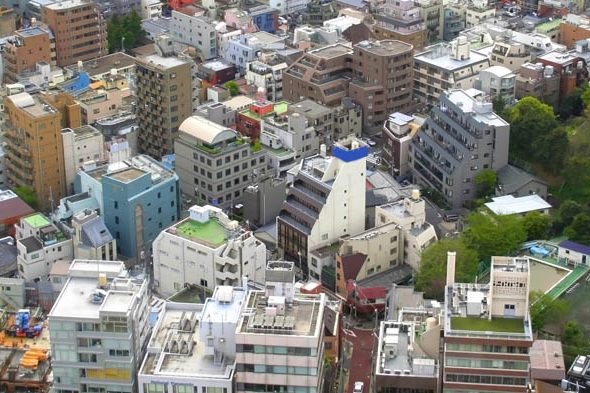
Living costs in Japan and especially in Tokyo are known to be among the world's highest. Japanese apartment sizes are usually smaller than in most other industrialized nations. In Japanese big cities, you will find modern skyscrapers and residential complexes, which are of very high standard and technologically very advanced, but there are also many houses, which look relatively simple and old-fashioned, if not to say „shabby“. For many Japanese, housing seems not to be a priority, and they prefer to spend their money on other things, such as food or cars. Anyway, even the small and „old“ houses in Tokyo are very expensive to buy or rent, as space is very limited and demand is high. However, there are ways to enjoy Tokyo without spending a fortune. The following accommodation options are feasibile for those who are on a Working Holiday: Share Houses “Share Houses“ are simply put, houses that you share with others. Even for many (young) Japanese, it is very common to live in a share house. They prefer it to staying at a small apartment on their own, because it is not only cheaper, but also offers other amenities, such as shared installations, common areas, and getting to know like-minded people. The term "social housing" exists in Japan, meaning that you share the house with other people of the same interest, e.g. "Rock music". Such houses would then have for instance a common collection of records or music instruments. There are several chains of share house companies in Japan. Some chains manage hundreds to thousands of small single-family houses with 4-5 rooms. You would share bathroom, kitchen and living room with the others sharing the house with you. These houses are often old-fashioned or even not well maintained in terms of sanitary installations, furniture, interiour design etc. Some other chains run large houses with 50-100 rooms that typically previously belonged to large companies that used these buildings for their employees. Such share houses exist from simple standard to luxury standard. The luxury share houses even have shared movie theater rooms, libraries etc. Share houses sometimes have quotas of how many Japanese and how many Westerners they want to accept. A dorm bed at a share house in central Tokyo is about 45,000-60,000 JPY per month. Single rooms are between 80,000-100,000 JPY. Cheaper options exist, but are often either very tiny, of very low standard, or you would have to share the dorm room with 12 or more people. If you stay in Yokohama, Saitama, Chiba or in the very West of Tokyo prefacture, rents are around 25-30% cheaper, but if you have to commute to central Tokyo every day for your work or language lessons, you don't really save, as commuting expenses apply (and commuting times of 60-90 minutes one-way). In other larger cities (e.g. Osaka, Nagoya) the rents are similar, but the rooms might be more spacious than in Tokyo. In smaller cities or in the country side, Share Houses might not exist. Host families Staying with a host family gives you the opportunity to practice your Japanese language skills and to get first-hand cultural learning experiences. On weekdays the Japanese host family usually offers you breakfast and dinner, whereas on weekends (Saturday and Sunday) they also provide lunch. Typical host families are usually composed of parents in their 20s or 30s with one or two small children, or they are in their 50s or 60s when their children have already left the parental household. Usually you don't find host families in central Tokyo as spaces are too limited to accommodated guests, but they would rather live in Chiba, Yokohama, or Saitama, Staying with a host family would typically cost you around 80,000-85,000 JPY per month. If you work or attend language lessons in central Tokyo, you would have to add commuting costs. Apartments In Japan, as a foreigner who stays for a limited duration of time only, it is not so easy to rent an apartment on your own. The reasons are that first, usually many landlords won't rent to foreigners as they expect language barriers, cultural differences etc. that just seem to much unnecessary complication to them if they can also rent to a Japanese. Second, landlords usually want to see that you have an unlimted fully salaried work contract, that you won't have if you are on a Working Holiday. Third, the minimum contract duration of renting an apartment in Japan is typically one full year. Fourth, you would have to pay a high procuration fee (reikin) to the real estate agent, which doesn't make too much sense if you stay for a relatively short time only. Fifth, most apartments come unfurnished, so you would have to buy all of your furniture.
What about the finances? As the salaries in Japan are relatively attractive, it is possible to finance your entire trip including living and travel expenses through the work you do in Japan. Many people achieve to even save some money, for instance to travel around and explore Japan or neighbouring Asian countries. However, you need some money before starting your trip, because when applying for the visa you need to have a flight ticket and you need to proof you have an amount of around 1500-2000 EUR/USD (depending on your nationality). You should be able to cover your living expenses for at least 1-2 months, just in case you don't find a job immediately. Let's have a look at the finances in detail! On the cost side, you have to consider: Your flight to Japan and back (you can use a flight comparison website to check rates) Rent for your accommodation: A dorm bed at a share house is usually around 45,000-60,000 JPY per month, a single room around 80,000-100,000 JPY. If you find considerably cheaper options in central Tokyo, room sizes are usually extremely tiny, the standard is poor, or they pack many people into a dorm room. You can find cheaper accommodation if you are willing to commute for around 60-90 minutes, but in this case you will have higher commuting expenses, which means you will probably not save a lot. Food and other living expenses (e.g. public transport). For Tokyo you should calculate with a minimum of around 280 EUR/300 USD per month (if your accommodation and job are in central Tokyo) Travel health insurance (around 40-50 EUR/USD per month) The services of an organization helping you: World Unite! for instance charge a one-time service package fee of 800 EUR/ 880 USD. The services included will definitely help you not only to save time to make all arrangements, pre-arrival and in Japan, but might help you to actually save money in Japan by avoiding (costly) mistakes, by finding cheaper accommodation, by getting membership terms on cheaper food on wholesale, and by helping you to find a job quickly. On the „income“ side, with the typical Working Holiday jobs, you will make (in Tokyo) between 890 and 1500 JPY per hour. So if you work part-time (28 hours per week), that’s around 100,000 to 170,000 JPY per month. If you work full-time (40 hours per week), we’re talking about 140,000 to 240,000 JPY per month. If you have a good level of Japanese and/or some professional qualification (particular IT or engineering-related, or as a professional teacher of English as a foreign language), you can make a higher hourly salary than the range stated above. With the help of an organization, it is realistic for most participants to find a job within their first month, so you should have enough money to cover one month without any job while doing job hunting. Now you can calculate how long it will take you to „break even“, which usually happens in the 4th month. So, from this moment your total earnings will exceed the total costs and many participants are actually able to save money that they can then use to travel around or to take back home.
The Working Holiday Visa The “Working Holiday Visa“ is currently available if at the time of application you are 18-30 Years old and if you are a citizen of the UK, Ireland, New Zealand, Germany, Austria, France, Denmark, Norway, Iceland, Portugal, Spain, Hungary, Poland, Slowakia, Czech Republic, Lithuania, Argentina, Chile, Taiwan, or Hong Kong. Citizens of Australia, Canada and South Korea can get the visa if they are 18-25 years old. You will have to prove a certain amount of money on your bank account, which might be lower if you hold a round way ticket and higher if you only have a one-way flight ticket to Japan. The exact amount differs depending on your nationality. It is typically in the range of 1500-2500 Euros/USD. Also, you can not be accompanied by dependents or children, you should be in good health and not have any criminal records. Please check the exact visa requirements on the website of the Japanese embassy of your country. With the Working Holiday Visa you can accept any remunerated job in Japan, except for jobs that "affect public morale in Japan", which include jobs in the gambling industry, and in bars, nightclubs or any other establishments where services related to the sex industry are offered, even if you are doing some other type of work at such establishment (e.g. if there are sex workers present at a bar, you are not allowed to clean there or to sell drinks etc.). With the Working Holiday Visa in your passport, you will get a Residence Card on arrival at the airport in Japan. Alternative options For nationalities and age groups that cannot get the Working Holiday Visa, an alternative solution to do something similar to a Working Holiday can be the use of a Student Visa. You can get a Student Visa if you enroll for at least 20 hours per week in Japanese language lessons at a Language School that is accredited to apply for Certificates of Elegibility for a Student Visa. The language school can then also apply for a Work Permit for you, which is usually granted if you get a Student Visa. This Work Permit allows you to work for up to 28 hours per week. These 28 hours are calculated as an average, so you can for instance, during your language lesson's semester breaks work full time, and then work a lower amount of hours while you take the language lessons. You can for instance book language lessons with World Unite! in order to get your Student Visa with Work Permit and then make use of their Working Holiday support services.
Experience life with a Japanese family as an Au Pair As an Au Pair you live with a Japanese family for a couple of months. You are supposed to look after the family's children and support doing the household while the parents are at work. You usually receive some pocket money, along with food and accommodation. Finding an Au Pair job in Japan can be difficult because many Japanese families are unfamiliar with the concept and often scared to allow a stranger penetrate into their privacy. There are some agencies offering Au pair jobs in Japan though. It is usually required to have childcare experience to be accepted into their programs. The host families they arrange for foreign Au Pairs to be placed at, are typically residing in villages or small towns, but not in the big cities, because in large cities such as Tokyo or Osaka, apartment sizes are small and there is usually no space to accommodate another person.


